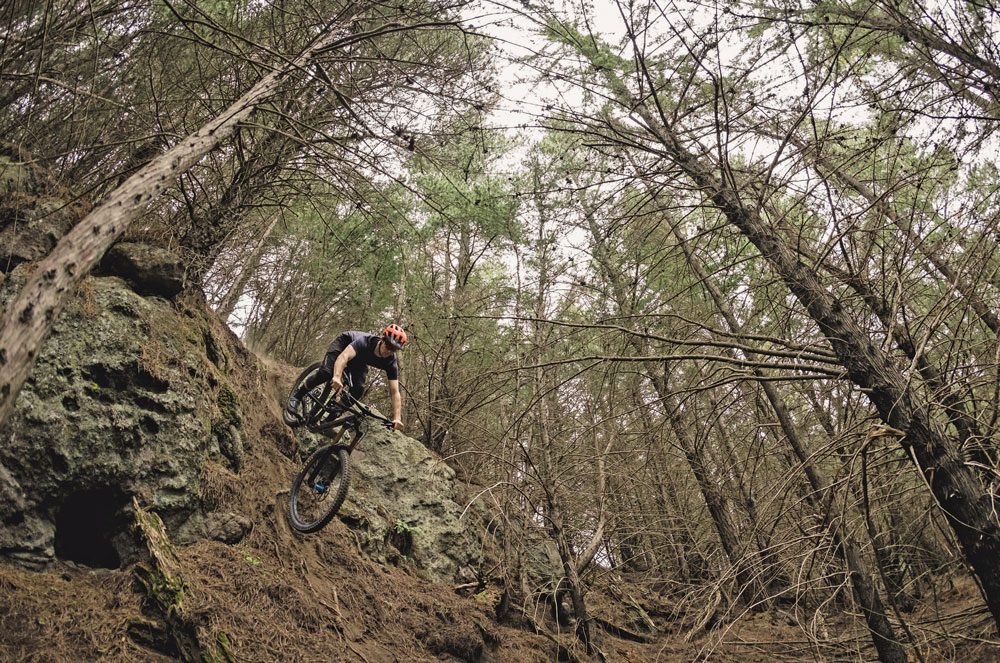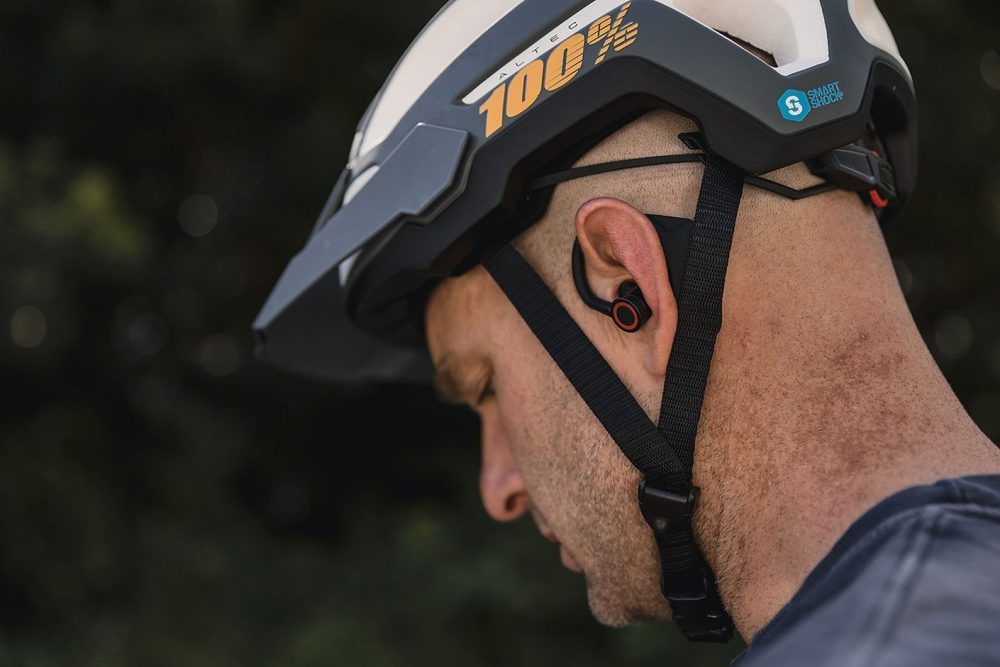Review: Smith Session Half-Face Helmet
“The visor has three positions, allowing you to stow your goggles when you don’t need them.”
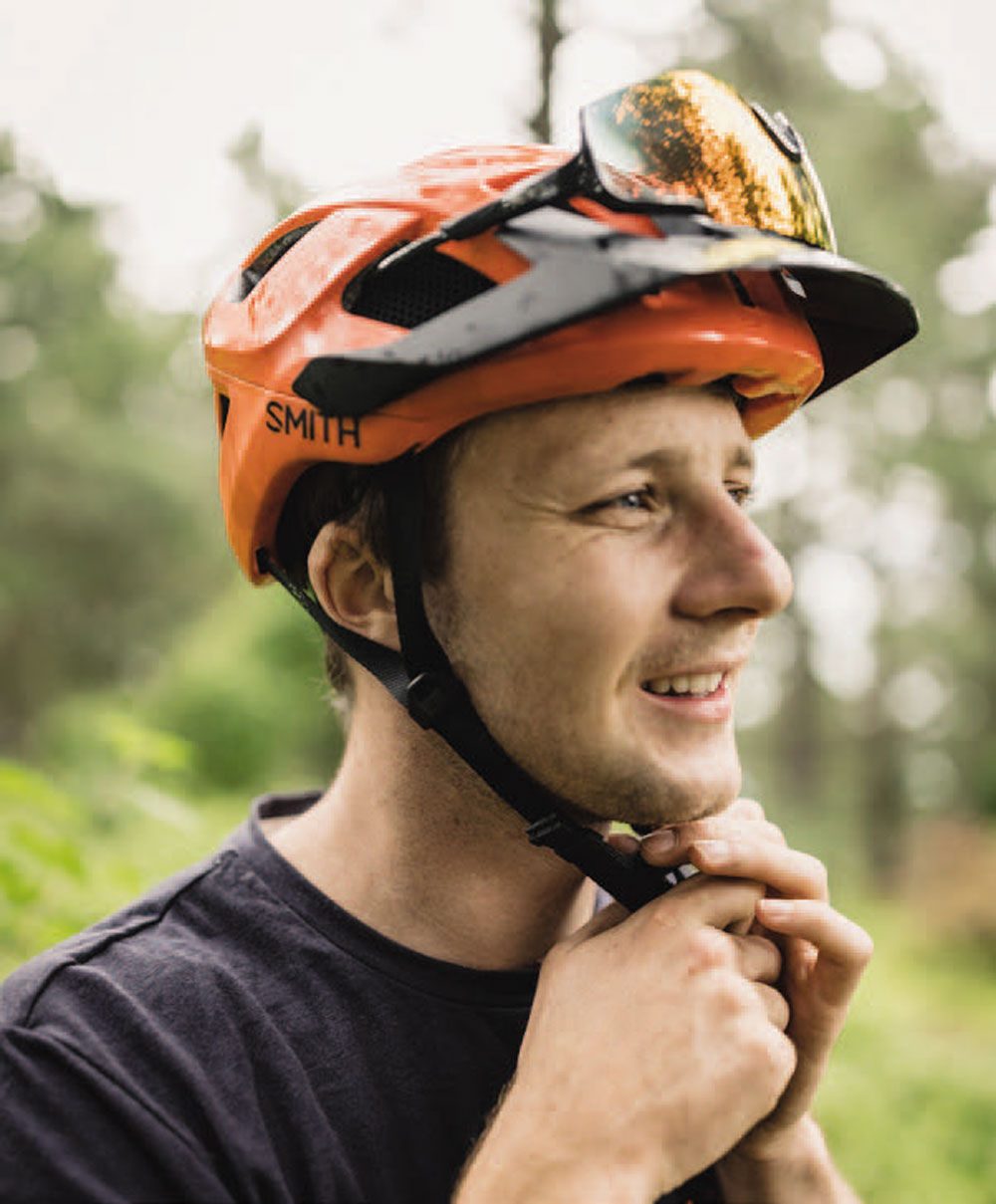
Most of us have had the Smith Forefront helmet out on the trails ever since it was released. Until recently, I thought it was the only offering Smith had in the MTB trail helmet range. I was wrong. Enter, the Smith Session. This helmet is packed with many of the same features as the pricier Forefront but comes in at a more affordable price. Call it a ‘mid- range’ trail helmet, if you will.
The Session differs in looks to the Forefront, with a design that is similar to a more classic MTB helmet. I’ve got a pretty small head, and those out there with the same issue will know how hard it can be to get a helmet that fits nicely and doesn’t make you look like a walking mushroom. This is where Smith have hit the nail on the head. The base sizing of the helmet (small) was great for me, and there is plenty of adjustment available with both a ratchet clicker and the ability to move the helmet’s internal ‘cage’ to dial in the fit. While the size and fit were great, I found that when riding more techy and rough trails (where your head moves around a lot) the helmet felt like it needed to be tighter than my initial fit. But that was an easy fix!
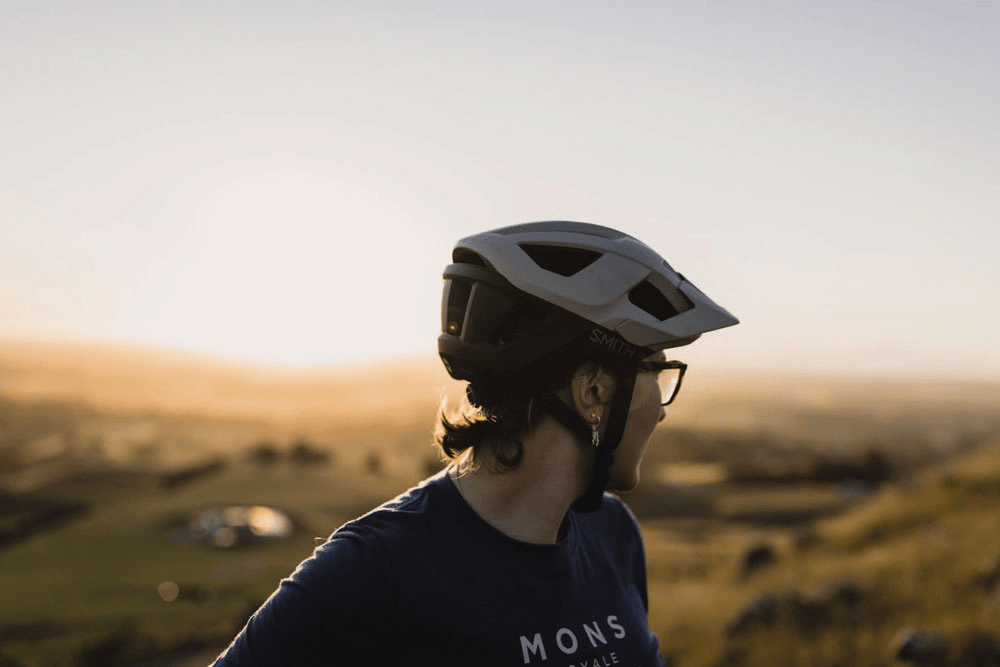
In terms of coverage, the helmet covers everything that needs to be covered – from the front to the back. The Session is paired with MIPS and Koroyd, making for a confidence-inspiring ride. It just makes you feel safe. There are plenty of vents (15 to be exact) to ensure your head stays cool while riding and not once did I feel like that was too much.
One of my favourite features was the integration with the Smith Flywheel glasses, which I was also reviewing. My previous helmet did not have any ability to store glasses, and I have often found myself forcing them in while riding – which usually ends up with the glasses damaging the helmet and not staying put.
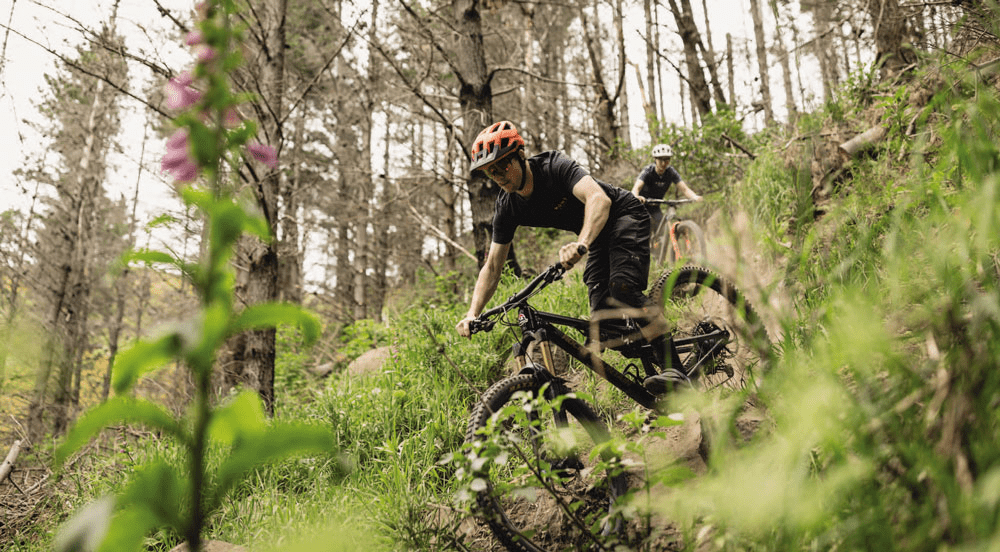
This feature is a game changer for those bigger missions when conditions change or you don’t want to wear your glasses any more. Simply take them off and slide them into the specially designed glasses port. They fit snug and secure, which means peace of mind for you. I am certain this would be the same for most other riding glasses on the market, but I found using the Smith glasses was seamless. If you ride goggles with your half-face, there are options for you too.
The visor has three positions, allowing you to stow your goggles when you don’t need them.
Overall, the Smith Session is a stylish helmet that boasts the best protection a helmet can offer, while packing a punch for its price. The Session is far from a ‘mid-range’ trail helmet and I’m looking forward to spending the rest of summer riding in it!
REVIEW: WILL KEAY
DISTRIBUTOR: SPORTIVE
RRP: $299
Review: Smith Mainline Full-Face Helmet
“Smith have taken no shortcuts when designing the Mainline. Everything feels durable and safe.”
Lightweight full-face helmets have become commonplace in the last four or so years. Pretty much every brand has one. Somehow, I’ve managed to own two lightweight full-faces from other brands in the last few years, and I’ve noticed a few commonalities between them. Every brand attempts to balance the following attributes: safety, comfort, weight and looks. Smith were a relative latecomer to the party, with their Mainline helmet. However, there is good reason. The Smith Mainline helmet strikes the balance of all four attributes perfectly and, in my opinion, takes the cake of the helmets in this category.
The Mainline boasts some wicked features. For starters, Smith have had an ongoing relationship with Koroyd for many years now. The Koroyd system has a series of integrated impact absorbent tubes that form part of the protective shell and, in addition to this, the latest version of the Mainline also offers MIPS. This gives the helmet a double tick for safety. The helmet is topped off with an adjustable visor and is fully ASTM F1952 downhill certified.
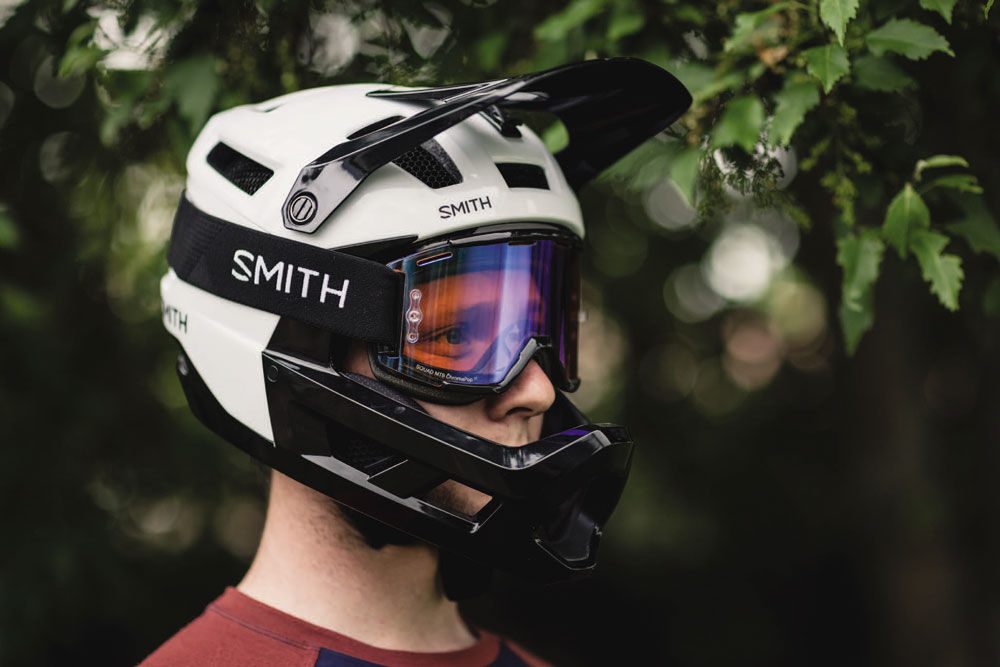
Smith have added the ‘AirEvac’ system to the Mainline, and this comprises 21 air vents that offer a supreme ventilation system. The vents at the front of the helmet take in hot air and redirect it over the head and out the back. This keeps your head cool, but not too cold on cooler days, making for a comfy ride. The helmet comes with three sets of pads of various thickness. This allows the user to fine tune the fit, which is pretty important when you are protecting your head. The helmet doesn’t have a ratchet adjuster on the back like some brands, but in my opinion the pad options mean you can get the right fit around all areas of the head, ultimately creating a more comfortable and safer helmet. The pads are coated with an antibacterial finish, meaning they are less likely to degrade quickly and start smelling. A simple D-ring closure, traditionally used on DH helmets, keeps the helmet secure. Once I dialled in the fit, I had no issues with the helmet feeling loose or moving when riding.
People are really into how much helmets weigh these days. The Mainline comes in at ~770 grams which is not the lightest full-face on the market, however, it is packed with the safety features mentioned above whilst also being comfortable.
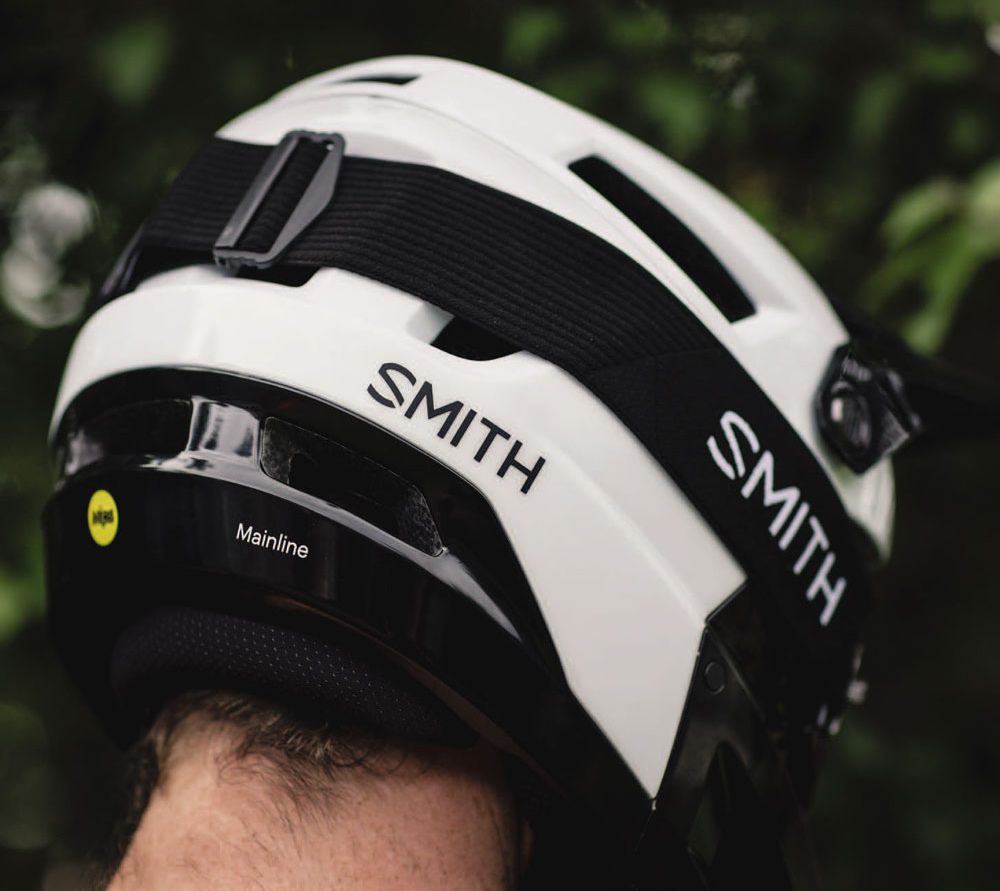
If I’m honest, once I had goggles on and was ready to ride, I didn’t notice the weight of the helmet; it still feels light. You forget it’s there and can even climb with it on, and you don’t feel hot and bothered like you do when wearing a traditional full-face.
The helmet looks good and rides well. It has good goggle integration and is contemporary and stylish but not too futuristic, like some others.
What I really noticed was that Smith have taken no shortcuts when designing the Mainline. Everything feels durable and safe, which is something I haven’t noticed with the other lightweight helmets I have ridden. Others will skimp in particular areas in order to save weight, compromise comfort and reduce durability. The quality of the Mainline is excellent and the finish is superb, making for a great looking helmet.
The Smith Mainline is a safe, comfortable, lightweight full-face that looks the part. What more could you ask for when putting your most valuable asset into it for each ride? This helmet would be top of the list if I was going to be buying a new full-face.
REVIEW: WILL KEAY
DISTRIBUTOR: SPORTIVE
RRP: $599
Feature: Chch in 24 hours
We all know the rough hand Christchurch has been dealt in recent years. From natural disasters to the horror of March 15 2019 and, more recently, the big C word, we’ve really been thrown a few curve balls. These events have brought with them unexpected change. In particular, the ongoing pandemic has seen us stuck in lockdowns and unable to connect with our friends in person. What remains unchanged, however, is the way bikes bring people together through a common connection. Back in June, my good friends moved back to Christchurch after three years away in the big smoke and we picked up right where we left off – just like the old days when we were growing up. They had ridden Vic Park, but they hadn’t seen some of the other riding areas Christchurch has to offer.


It’s funny how you get stuck in your ways with riding. You frequent the same trails and the same routes. However, when it came time to planning our catch up ride, it dawned on me that Christchurch is a now an incredibly accessible city for mountain biking. We have a huge variety of trails that are all interconnected, with great options for refuelling and hydrating along the way.
Kicking off the day with breakfast and coffee at home, we chatted and made a plan for the day ahead. We’d start out at Christchurch Adventure Park (CAP), which was once just a series of trails in the old Worsley’s Forest. Back then, it was a pretty low-key affair but an important piece of the Christchurch riding scene. When the park was built and opened in 2016, it incorporated some of the original trails, which my Auckland pals were familiar with as the last time they’d ridden in this area was before the park opened.
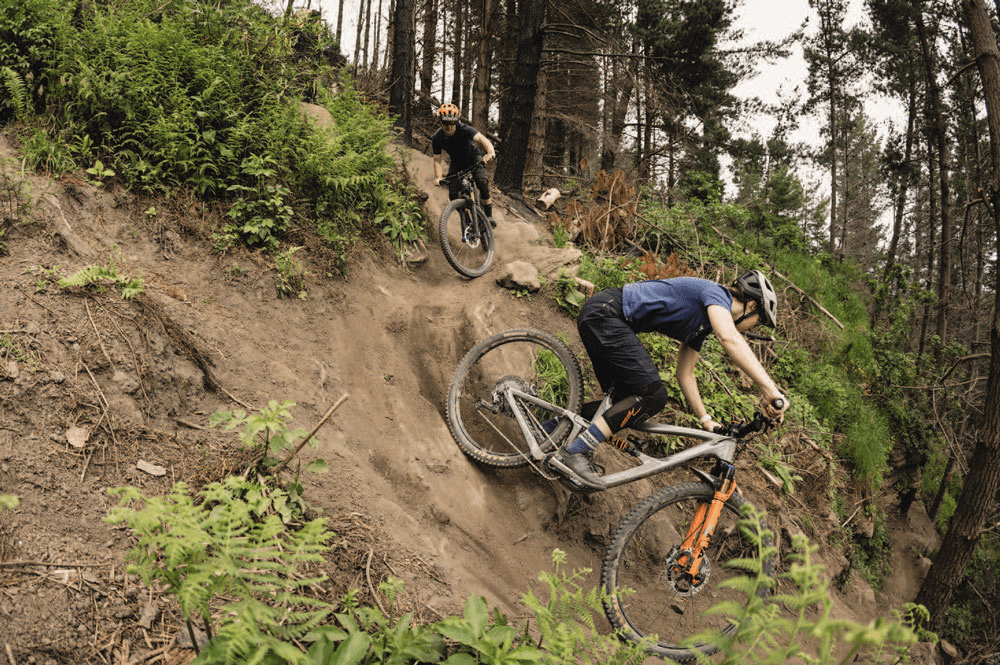
Unfortunately, In 2017, the park itself suffered a blow from Mother Nature when a large fire ripped through and destroyed the majority of the trails – a mere eight weeks after originally opening. After many hurdles getting back up and running, the park now boasts an excellent array of trails which are all accessible by chairlift, but the reality of the fires – and the challenges faced when rebuilding the trails – are evident. Trees that were badly burnt on the outside still stand, while entire areas have been completely decimated as trees have succumbed to the damage caused by the fires and fallen. It’s a stark reminder of the power of nature – something Christchurch is sadly all too familiar with.
One of the park’s latest offerings is a trail called Wasabi. Weaving through an area of tree fall littered with foxgloves, the trail tightly drops into a traverse with rocky crags towering overhead, before heading into a couple of technical rocky sections and some dusty corners full of once-burnt material. It was refreshing to be able to reintroduce friends back to CAP after a few years away and have them reminisce the old days riding in Worsley’s, after riding the likes of Wasabi.
Having a chairlift in town really opens up the options, so we made the most of it after our lap of Wasabi, by heading back up and pedalling along Christchurch’s iconic Summit Road before dropping down into Lyttelton for lunch at Co-Op. This café has a great view over the harbour and an awesome menu, catering to every taste. We tucked into lunch and enjoyed a coffee before getting back on the rigs and heading out to our next stop of the day.
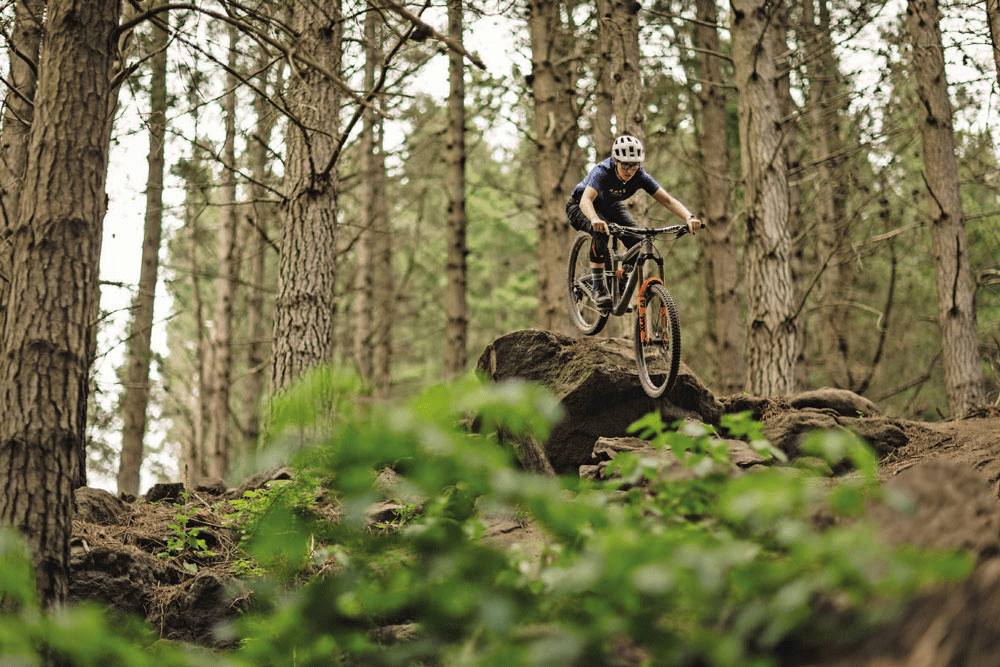




Riding in Lyttelton is a bit of a ‘phoenix rising from the ashes’ type story. The area always had trails but, following the 2017 fires, the area rose to incredible popularity as riders looked to get their forest riding fix. Recently, more trails have emerged. We pedalled up a few times and dropped down some of their black graded trails, stopping en route to session some of the techy features in the forest. The vegetation is dense and green, making for a unique experience compared to riding in the rest of the Port Hills network. The stoke factor was high – thanks in part to sharing the experience with mates who were riding it for the first time. Short climbs and fun descents mean there is plenty of time to chat about recent happenings and life movements.
After a few hours shredding in Lyttelton, we cruised back through the streets of the port town and winched back up to the Summit Road before dropping down into the city via Rapaki Track. We rolled around the banks of the Heathcote River, eventually pulling up at Moon Under Water to wet the whistle after a solid day of riding. Moon Under Water is a craft beer spot that has gone from strength to strength in the last few years, despite the adversity faced in the hospitality industry. The bar is incredibly popular with the riding fraternity, and it’s not uncommon to see the entire outside of the building lined with bikes after a school night ride. We enjoyed a cheeky burger and fries, happily washed down with a hoppy number. After some more much-needed catching up, we got pedalling – heading west to try and get the best views of the sunset. We eventually found ourselves above the Crocodile MTB Park, ripping the grassy turns as the sun set.


Once the sun had disappeared, we headed back home to debrief on an epic day of riding. We were all in agreement that we’d never thought a day of riding like this would be possible in Christchurch. While change can be hard to adjust to, the results are often worth it. Life moves fast and shit happens, but it all gets put in perspective pretty quickly when you realise three years has flown by. Life is short; look after your mates and live harder.
Words: Will Keay
Photography: Cameron Mackenzie
Review: Smith Flywheel Sunglasses
“The ChromaPop lens gives rise to better definition of natural colours and allows more clarity while moving. I’ve been sceptical about this sort of stuff in the past but, to be honest, it just works.”
I used to think riding glasses all served the same purpose: enhancing your vision while protecting your eyes. In recent years, we’ve seen an influx of styles which look as if they are from the ‘Back to the Future’ movie franchise. The Smith Flywheels are no different; they have a big lens that covers the majority of your face, with a variety of frame and lens colour options. I’ve been critical about the look of riding glasses for a while, but having the opportunity to review these glasses has really changed my perspective.
Smith are well known for their quality eyewear, so I had no reservations when asked if I wanted to review the Flywheel glasses. The Flywheel have been designed with a ‘modern meets retro’ look in mind. The frame is made from TR90 thermoplastic, giving rise to desirable attributes for mountain biking glasses: light, flexible and durable. Once I put them on, I realised pretty quickly that these modern riding glasses are made for the eye of the user. They are insanely comfortable and you get a full wrap around your face. The previous glasses I had would sit further down the nose, which resulted in light getting let in around your peripherals. The Flywheels hug your face in a good way, and there is also some adjustment in the rubber nosepiece so you can achieve the best fit.
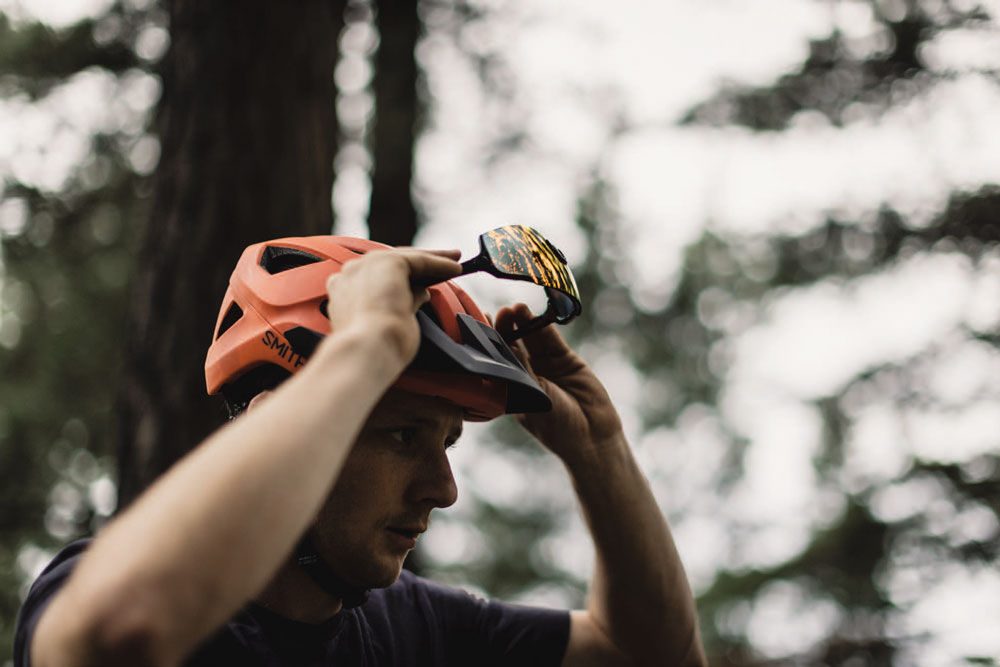
The ChromaPop lens (which is designed to filter crossover between blue and green light, and red and green light) enhances the view dramatically. The science behind ChromaPop is that the retina (part of the human eye) struggles to separate these overlapping colour waves, so the lens acts as a filter to help separate them. In short, the ChromaPop lens gives rise to better definition of natural colours and allows more clarity while moving. I’ve been sceptical about this sort of stuff in the past but, to be honest, it just works. The lens is also smudge resistant and 100% UV resistant – all good things to have in a pair of mountain biking glasses. One possible downside, for some people, may be that the glasses don’t offer an interchangeable lens. I had no issues with the lens I selected, and there are a few options in the line-up, so just choose carefully when purchasing.
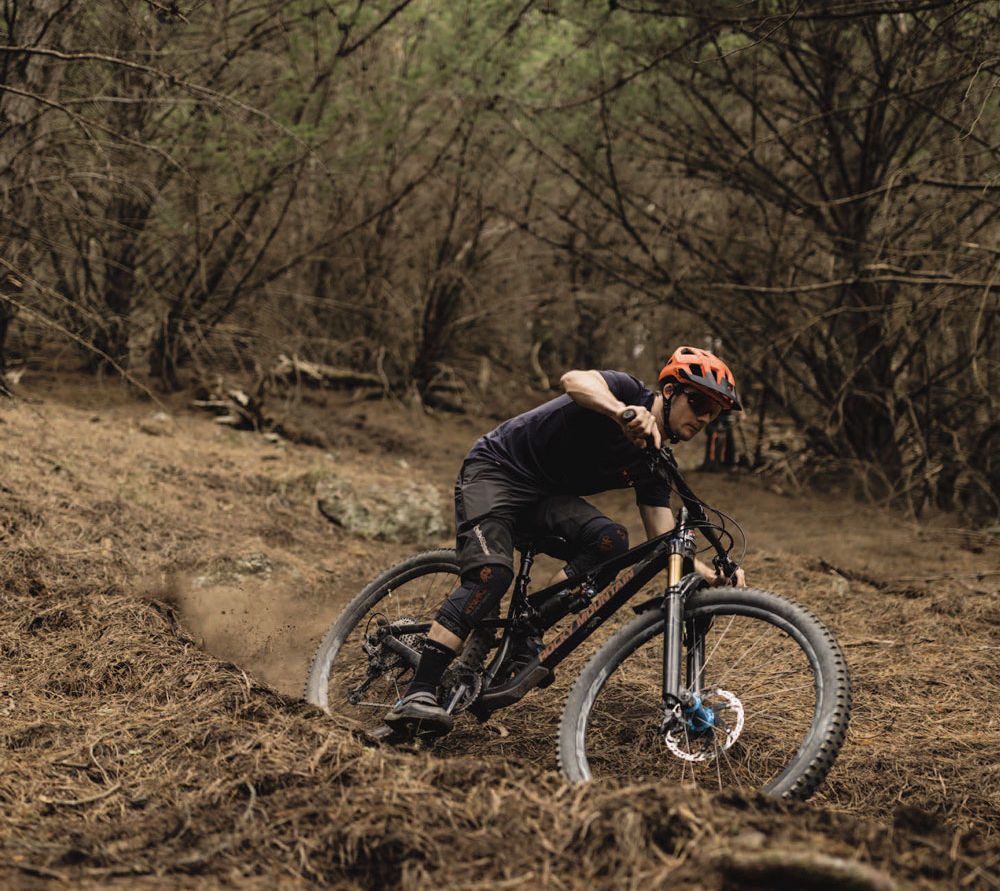
When riding, the glasses stay put and deliver an excellent field of vision, despite being labelled as ‘medium coverage’. They are not heavy on your face and even after several hours of riding I didn’t have numbness behind the ears or an achy nose (which I’ve had in the past, after several hours of riding). The arms on the glasses have locked hinges meaning they are super easy to take off when on the go, and they tuck nicely into the helmet (see my notes on integration in my Smith Session helmet review). Having read some other reviews of the glasses, I noticed some reviewers said the lenses fog up easily, however, I had no foggy moments and I’ve ridden these glasses in a variety of conditions where I would’ve expected them to fog up.
I found the Smith Flywheel sunglasses to be extremely comfortable, and I could easily wear them all day. The quality of the ChromaPop lens really does enhance your vision, making for an enjoyable ride. I highly recommend the Flywheel glasses for anyone who is looking for a pair of riding glasses that can be used in the wide range of conditions we have in New Zealand. •
REVIEW: WILL KEAY
DISTRIBUTOR: SPORTIVE
RRP: $180 (WITHOUT CHROMAPOP), $269 (WITH CHROMAPOP
Feature: Shredding Queenstown
It would always astound me how, on any given day in summer, you could be standing in that hour- long lift line in the shadow of Skyline, watching an almost one-to-one ratio of international riders and pros alongside locals. People would flock from all corners of the globe to ride in Queenstown, and many would call it home for those key months as they trained for the coming season.
The world’s fastest weren’t the only ones preferring to use Queenstown as their base of operation though. Over the last few years, as the mountain bike media landscape has changed, so too has the way projects have been shot, with a major emphasis on the location. If you were to look at any random selection of film or photo projects, not just with Kiwi athletes, I guarantee the Queenstown Lakes region would feature.
Given the depth of talent residing in the south, it’s always baffled me as to why there hadn’t been a world- class event hosted on the slopes above the Wakatipu Basin. That’s not to say the likes of Mcgazzafest, or any one of the locally organised races aren’t world- class nor lack the talent pool, but rather an event recognised in all four corners of the globe.
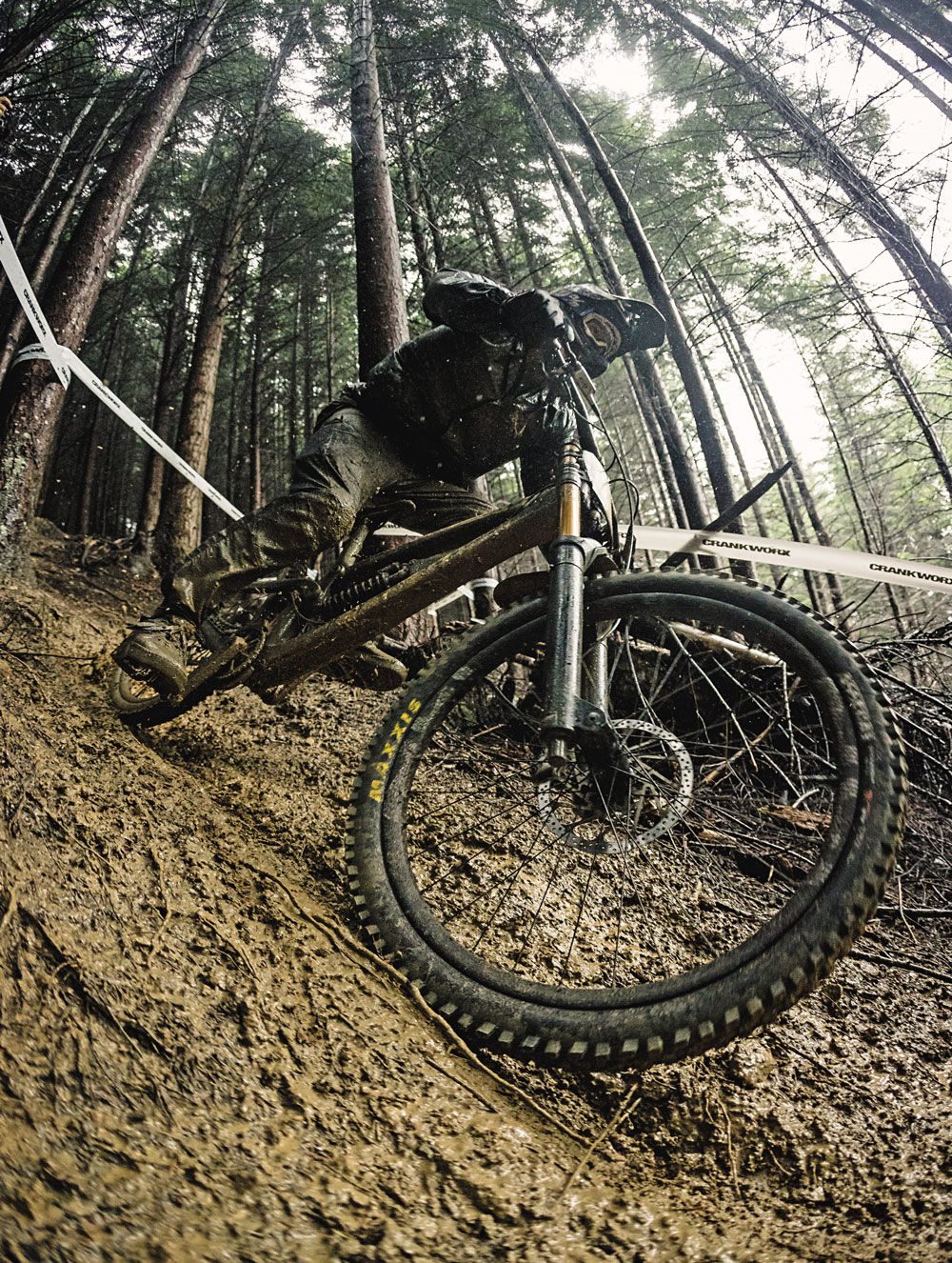
When it was announced that Crankworx would be taking the show on the road in the form of a multi-stop summer series road trip, speculation began as to what the locations would be, and for what disciplines. It was of both little surprise and great excitement when it was finally announced that the downhill event would be held in Queenstown. It was the logical location for such an iconic event, and the rightful home in the minds of many. The biggest surprise was the addition of a pump track event held alongside, on what we’d later come to find was a brand-new course built to launch with the race.
The benefit of an event like the summer series coming to town, is that the circus brings with it some of the world’s best athletes, transplants them into a tight-knit community and creates the opportunity for local pros, riders on the fringe, and aspiring next-generation rippers to rub shoulders with some of the world’s best. Add to that a purpose-built course that’s then handed back to the community for all to use, in a town where that was the last thing remaining to complete the trifecta, and you’ve got everything anyone would need to progress and grow.
We couldn’t not attend the inaugural Queenstown CWX Downhill, with the stage set for it to be great. It wasn’t just the athletes; we were curious to see how it would compare to the Rotorua-based main event.
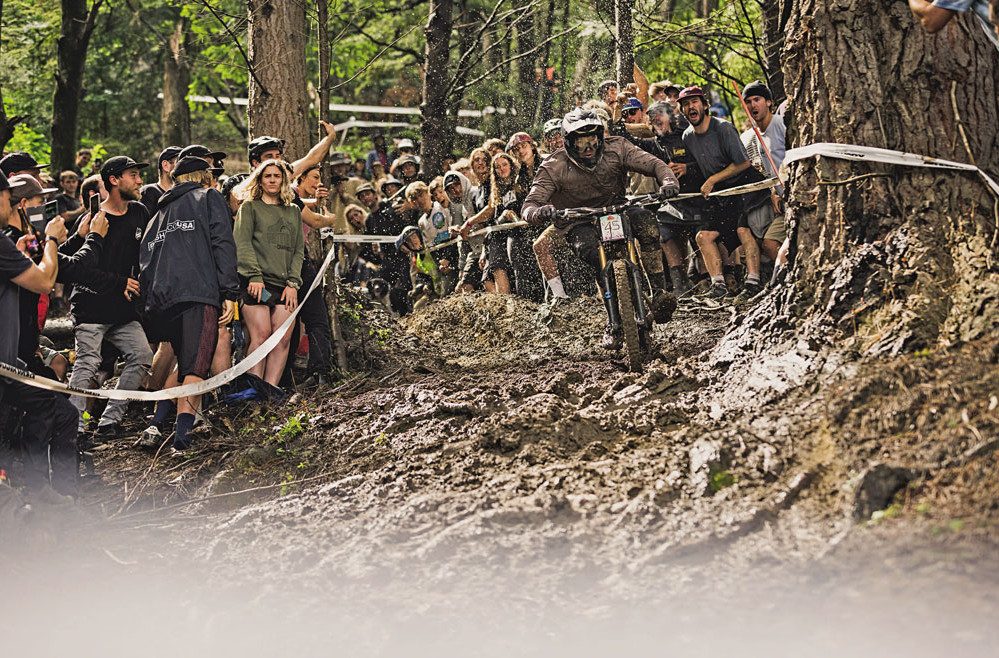
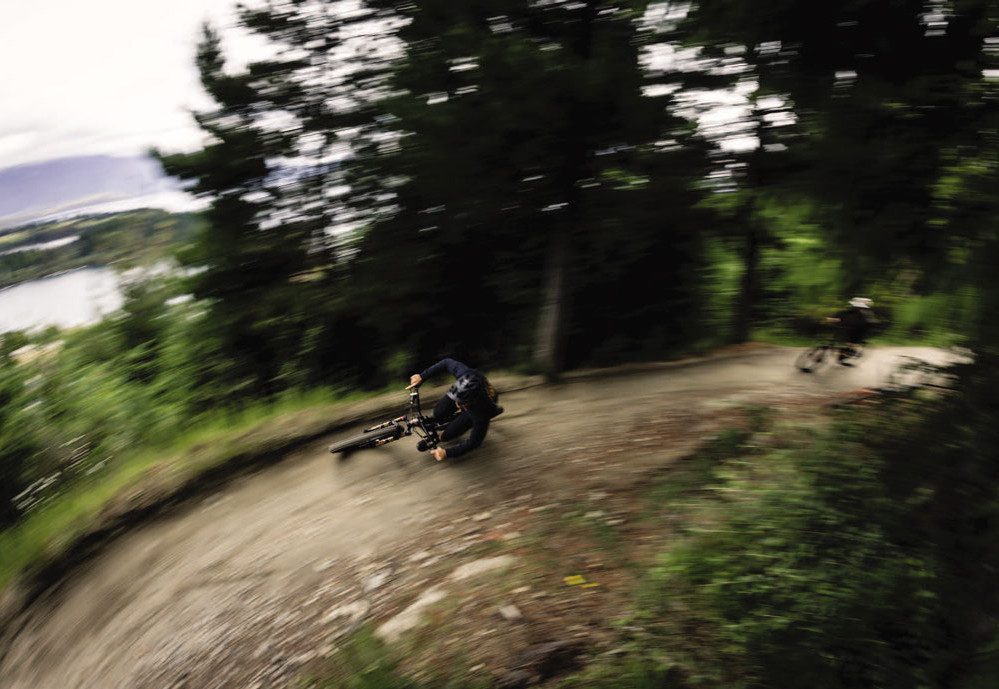
With our Covid restrictions changing shape, and easing somewhat, right on the eve of practice, I don’t think anyone quite knew what to expect. It wasn’t until race day when the storm rolled in that the true colours began to show. Overnight, between practice and race day, the heavens opened, soaking the steep and rather fresh course. What greeted us all in the morning was a mud bath, a complete slip and slide, and the makings of a mud race for the ages.
The orange-light open-season meant spectators were once again allowed trackside, and whilst Crankworx didn’t actively promote spectatorship, they came marching two-by-two, armed with refreshments to see them through the day. I don’t think anyone could have planned a wilder restart and race if they’d tried. The potent mix of a proper mud race and the event we’d all been waiting for combined with an easing of Covid restrictions and enthusiastic humans who’d been locked down for the end of winter, resulted in a heckle-fest even Crankworx staff were comparing to the heckler’s rock of old. Safe to say, it definitely made for some of the most colourful scenes I’ve ever witnessed at a race.
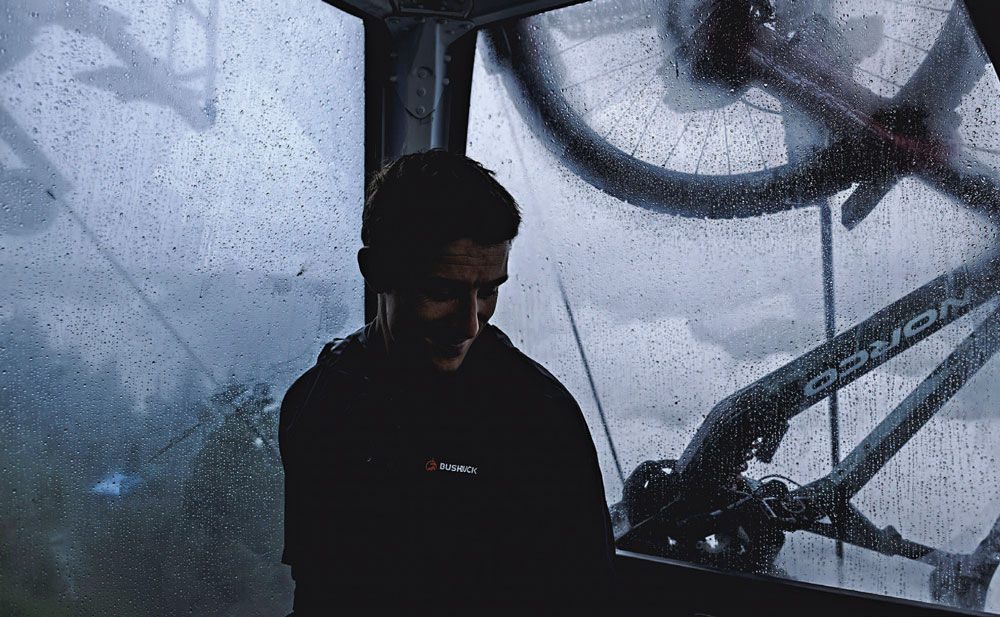
New Zealand featured heavily on the leader board, with Kiwis taking out the top five placings in the men’s division and Sam Blenkinsop nailing the top spot. Over in the women’s division, Jenna Hastings took out a solid 4th place, whilst fellow Kiwis, Melissa Newell and Kelsey Timpany, came in 8th and 11th respectively.
I don’t think anyone could have planned a wilder restart and race if they’d tried. The potent mix of a proper mud race, the event we’d all been waiting for, an easing of restrictions, Crate Day, excessive drinking and loose-moralled humans resulted in a heckle-fest even Crankworx staff were comparing to the heckler’s rock of old, and made for some of the most colourful scenes I’ve ever witnessed at a race. In other words: nothing short of complete mayhem. Off the back of the festivities and continuing the theme of ‘new and improved’, it was only fitting to hang around a couple of days, revisit some old faves, and go exploring to see what was new in the trail department.
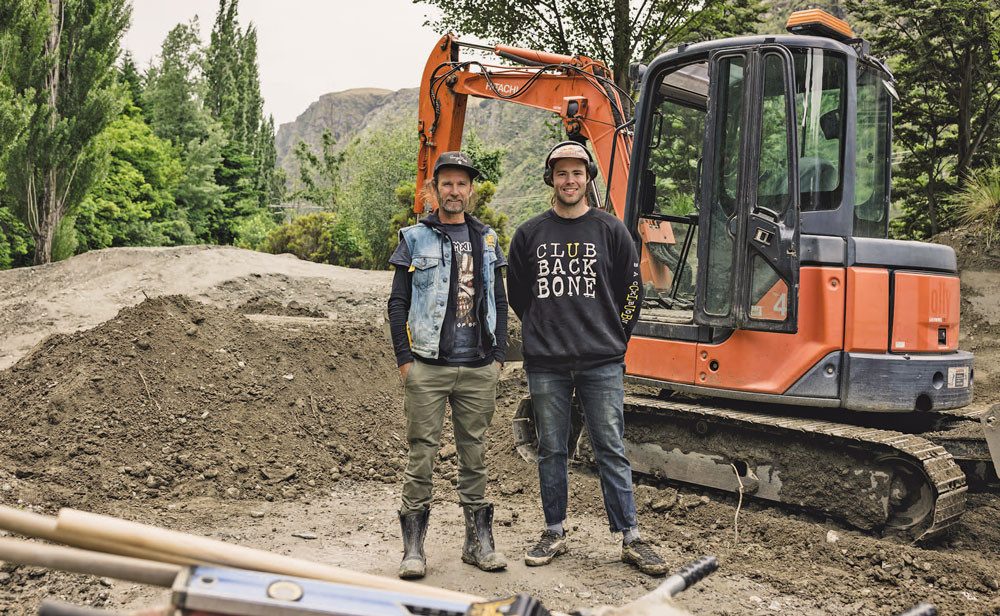
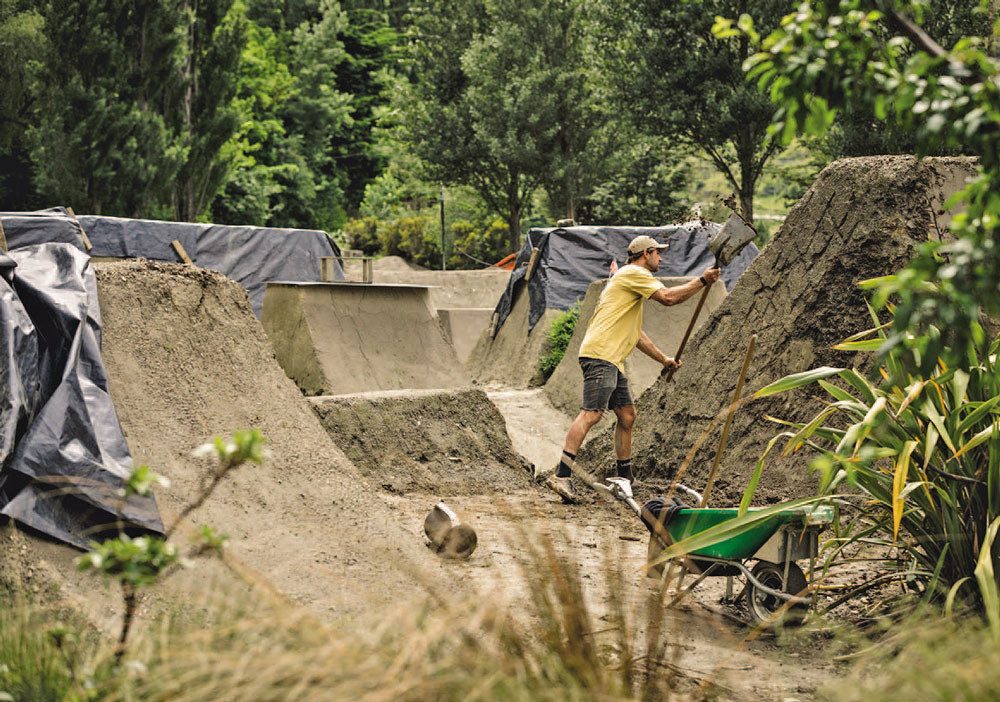
GORGE ROAD
The benefits of mixing pros and locals has been prevalent for some time but, more recently, it’s been on full display throughout the Gorge Road Jump Park saga. After several stays of execution, and despite the best efforts of the Gorge Road riding community, it seemed that arguably the most iconic community jump spot in the world, would meet its end this year. However, with considerable effort from Gorge Road locals, including mainstays Nathan Greenwood and Remy Morton, Queenstown-based entrepreneur, Rod Drury, and legions of domestic and international riders, the future of Gorge Road has been secured for the long term.
To find out a bit more about what had been going on since the trails were saved, we headed down to Gorge Road to find out about the plans for the future. When we arrived, it was clear that a fair amount of work was underway in several sections of the park. Speaking with Remy Morton and Nathan Greenwood, finally having some long-term security over the future of the trails has meant that a commitment can be made to some key infrastructure work for the jumps. Both Remy and Nathan explained that a major focus for the rebuild that’s currently underway, is to improve the durability of the trails.
These durability upgrades include some extensive drainage work, along with re-grading the slope the trails sit on, and lowering the height of the sections between jumps. The plan is to have water drain away from the jumps more easily following wet periods, hopefully reducing damage to the trails after heavy rain.
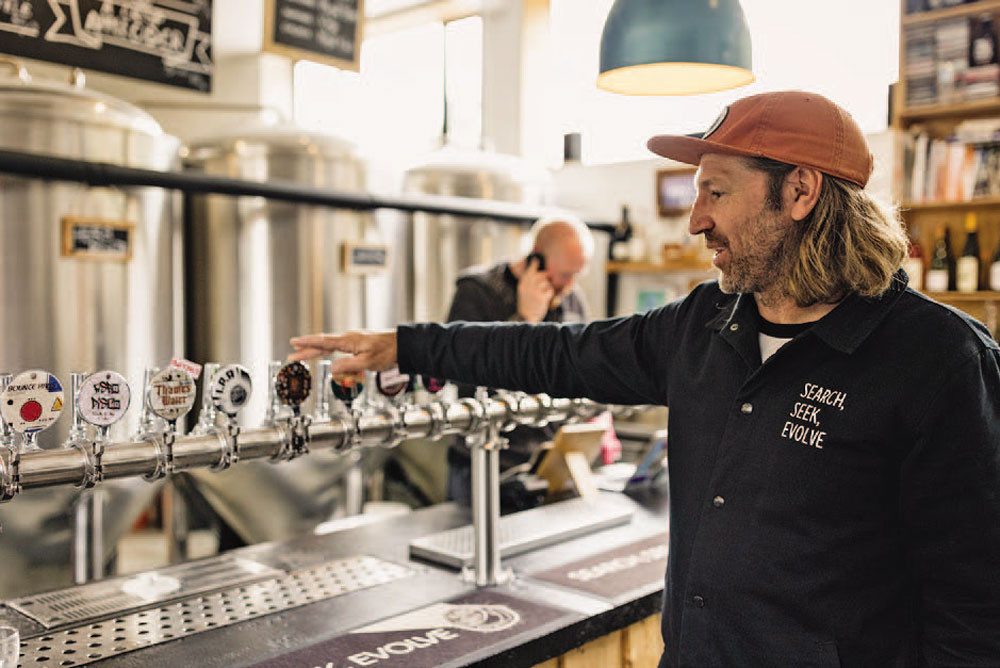
Elsewhere in the park, Remy’s fellow Flux Trail crew members, Dave McMillan and Matt Begg, were busy stacking and slapping on one of Gorge Road’s many sculpted landings. The beefed-up landings are another one of the big durability upgrades that it’s hoped will accomplish the ultimate goal of having the jumps open to more people, more of the time. In doing so it will also help to ensure the high aesthetic standard of the jumps that Nathan and others have worked so hard to achieve, is carried on as a key feature of the trails.
As well as the infrastructure upgrades, the smaller lines in the park are receiving a major overhaul, while the old wall ride has been removed with a new extension underway to push the trails further down the site. Speaking with Nathan, he pointed out that these improvements and upgrades are one stage of building out his ultimate vision for the trails, that they’ll continue to work towards in the years ahead. A big part of that vision is having a place where young riders can come and progress themselves, not only as dirt jumpers, but as all-round riders.
The Gorge Road upgrades are just one of many trail upgrades and developments that are either underway, or have been completed, in Queenstown in the past few months. Later that afternoon, we found ourselves on the Skyline Gondola sampling some of Ben Lomond Trails refreshed trails. On the topic of refreshment, we stopped by local haunt, Searchlight Brewing, on our way back down Gorge Road, to sample some of their current offerings.
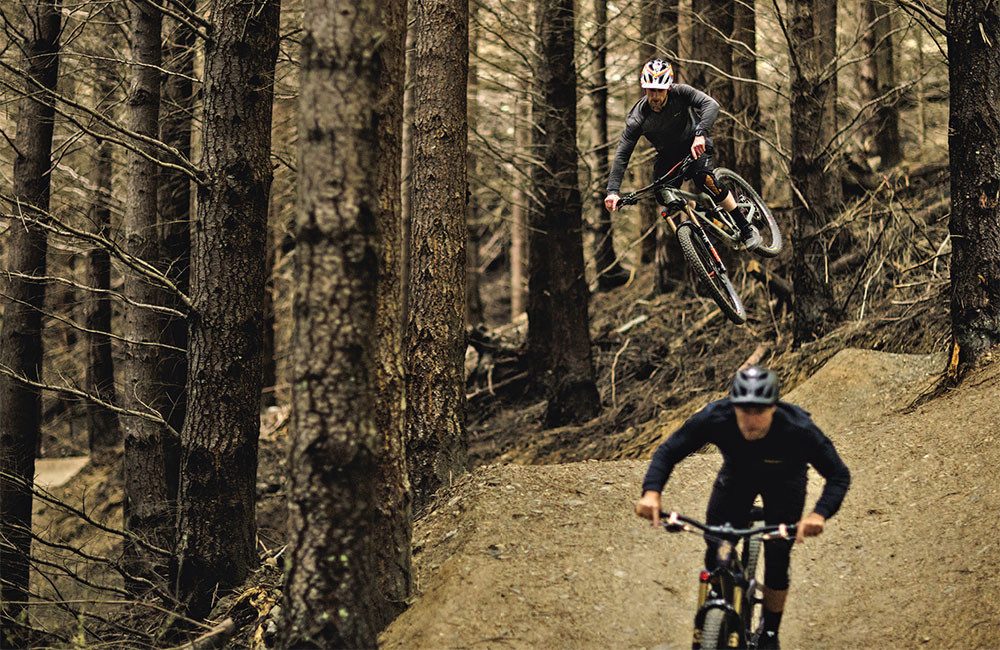
SEARCHLIGHT
In a town that’s pretty synonymous with hospitality, Searchlight doesn’t fit the standard mould of posting up on the lakefront and watching the sunset. Tucked away in Industrial Place, just up the road from the iconic Gorge Road trails, Searchlight takes a bit more local knowledge to find. With its inviting beer garden and tap-room, along with the brewery itself on full display behind the bar, it’s the kind of place you and your mates head to for a genuine experience. Speaking with Clayton, who’s recently taken over the brewery with his partner Sharon, from founder Lewis, his enthusiasm and passion for Searchlight is infectious. From comedy nights to live music and quiz nights, Clayton tells us that Searchlight wants to give the community a heap of different options to come down, hang out and enjoy some great beer.
Aside from acting as a hub for people to meet up and hang out, Clayton also wants to use the brewery to support different local scenes. A great example of this was Searchlight’s recent award-winning ‘can art’ on one of their newest Hazy Pale Ales, Ladies of Dog Town. Rather than going down the illustration style route, Searchlight collaborated with local photographer Melissa Clark and local female skaters to feature a photo of them skating down Coronet Peak’s access road. Word on the street is that another collaboration, paying homage to the Gorge Road trails, may be on the cards so look out for that at some point in the future.
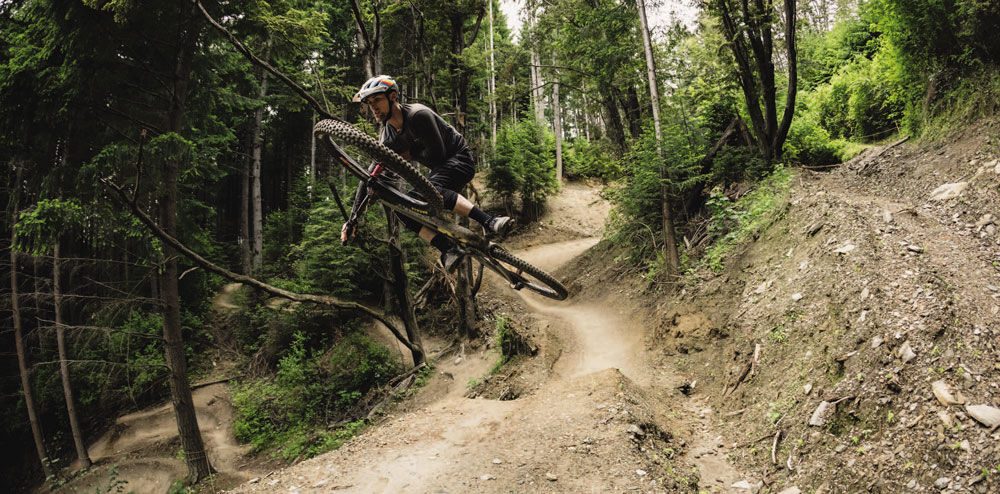
SKYLINE
After some refreshments at Searchlight (but not too much) we headed over to Skyline for an afternoon rip with Queenstown shred lord, Reece Potter. Continuing the refreshment theme, Ben Lomond Trails trails received a massive and much needed refresh prior to opening for the season. First on the list for us was the rebuilt Vertigo, littered with pull-over gap options, shark fins and deep turns. One thing I always find with Queenstown trails, especially the jump trails, is how they always seem to have the perfect shape to them. This makes them a lot more predictable and fun to hit for the first time, as you can be pretty certain about how the bike’s going to behave as you go off the lip.
After dragging ourselves away from Vertigo’s endless supply of fun shapes, we had a brief interlude down the more natural GSD. In contrast to the open, fast and flowy Vertigo, GSD offers the perfect look into the darker, rocky, rooty side of the Ben Lomond Trails. Coming from a place like Christchurch, where the trails largely turn into an ice rink after some rain, I was a bit more apprehensive about the level of grip on offer down a damp GSD, especially on a blind run. As it turned out, there was a good amount of grip on offer, and we were able to make the most of GSD’s rock laden features. Near the end of the trail, things took a bit of a turn as Cam’s camera pack took him for a lengthy roll through the last set of said rock features.
After a mandatory roll through Thunder Goat’s scenic right hander, and a quick clean-up for Cam at the top of the gondola, we made our way down to the refreshed Original trail. In the past, this trail has always been a fun but fast run down the lower part of the hill. The refreshed version feels like it takes the shapes of Vertigo, merges them with a bit of Huck Yeah and brings them into the lower part of the hill. Flowy and fun are probably the best ways to describe the new Original, and the fact Reece and I were voluntarily pushing back up for another run through the features tells you pretty much all you need to know.
After a few runs through the epic series of new turns near the bottom of KY, and the final features down Original, it was time to cruise out to Arrowtown for a post-ride beer and dinner at the Fork and Tap.
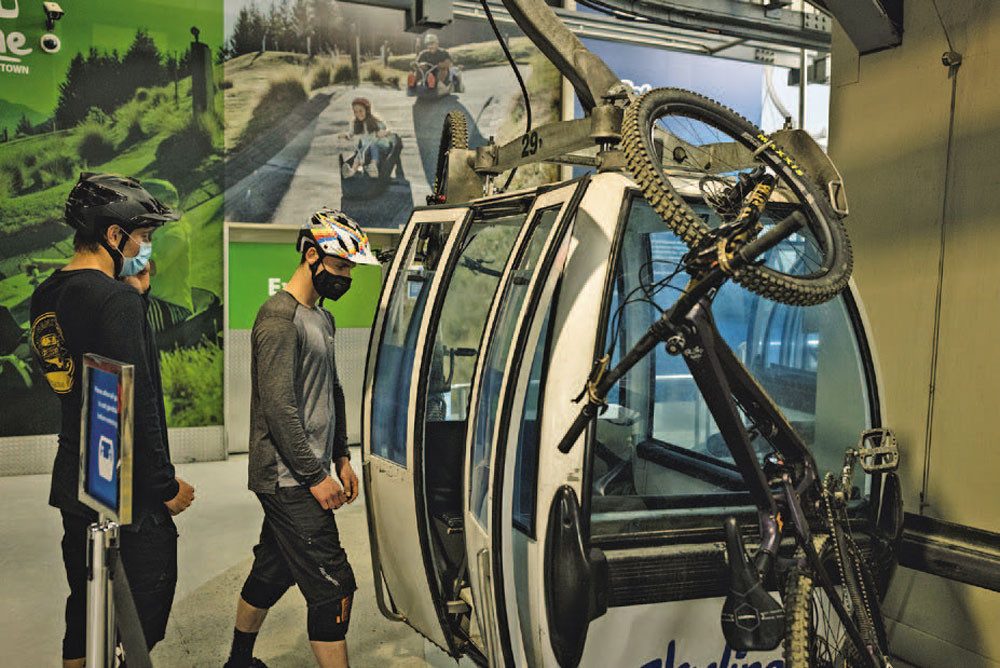
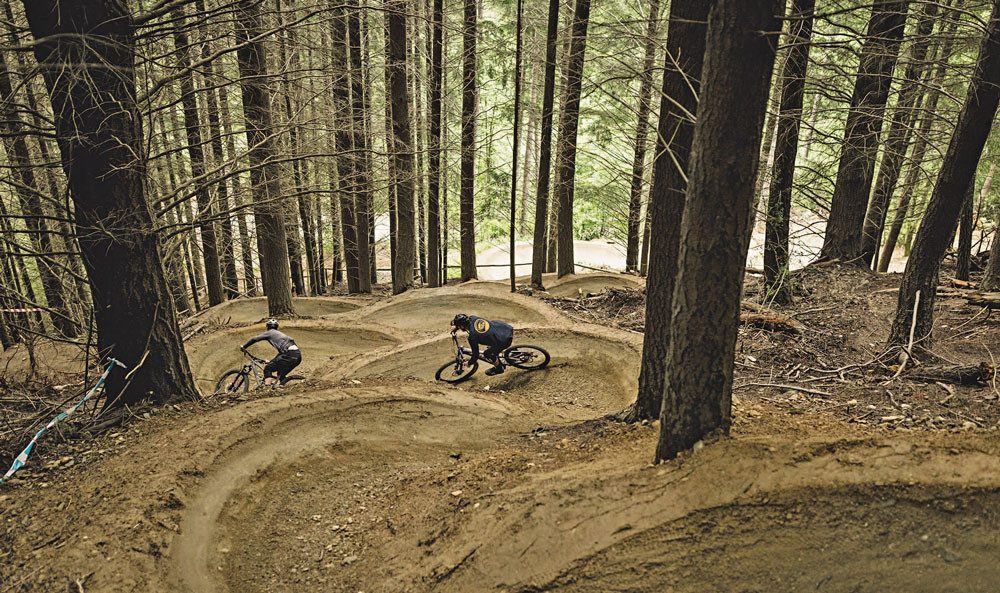
FORK AND TAP
Our original plan had been to head to the Fork and Tap via the Slip Saddle and Bush Creek tracks that end up right at Arrowtown. A wet afternoon the day before saw Skyline open at midday and this, coupled with some big jobs lined up the following day, saw us taking the scenic drive out there instead. Ideally, you’d have a run right from the top of nearby Coronet Peak all the way down to the Fork and Tap at the bottom on a warm summer evening.
Housed in one of Arrowtown’s many historic buildings, the Fork and Tap offers a great post-ride atmosphere, inside and out. After being greeted by the friendly staff, we opted for a table inside and took our picks from the great selection of beers and food as the day wound down.
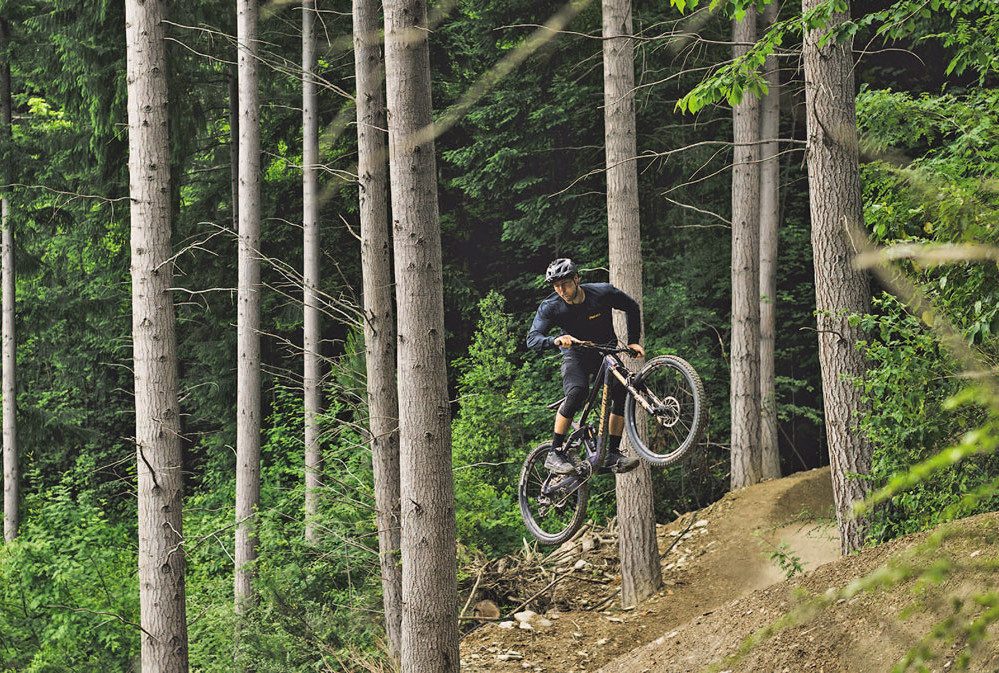
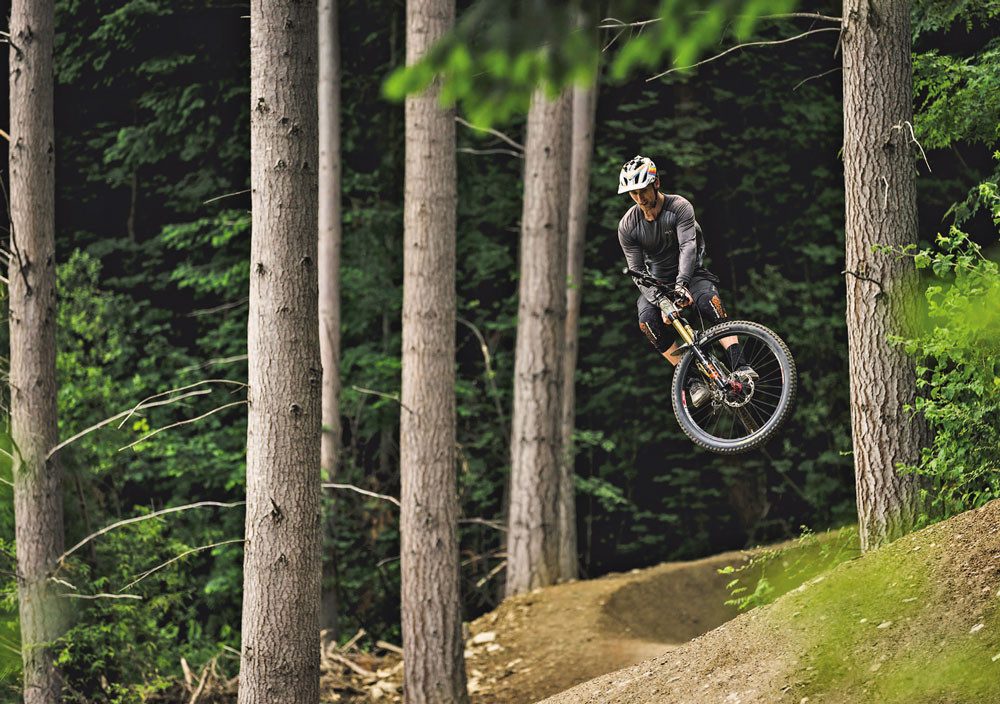
CORONET, HELI-BIKING AND FERNHILL
After easing into things the day before – in part thanks to the slightly wet start – we awoke to a sunny day and knew we were on for one. We headed out to Arrowtown to meet up with Reece before piling in the car and boosting up to one of New Zealand’s most scenic carparks, at Coronet Peak. Following through with yesterday’s original plan, we headed up to the top on the lift and made our way down the Coronet XC trail to Slip Saddle.
Slip Saddle always offers a challenging ride down and, with a little bit of moisture from the previous days’ rain, this time was no exception. After sliding our way down Slip Saddle’s steeps and gullies, we found ourselves at the top of the recently refreshed Bush Creek trail. While always offering a cruisy warm down after a Slip Saddle run, wet feet were usually a guaranteed outcome after Bush Creek. The recent work by locally based Elevate Trail Building, has added bridges, culverts or rerouting at all former crossing points, and made for a much dryer run.
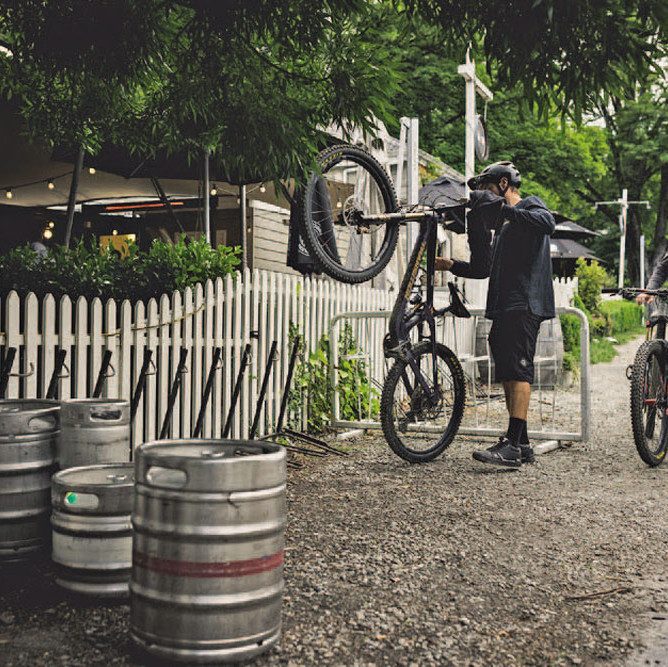
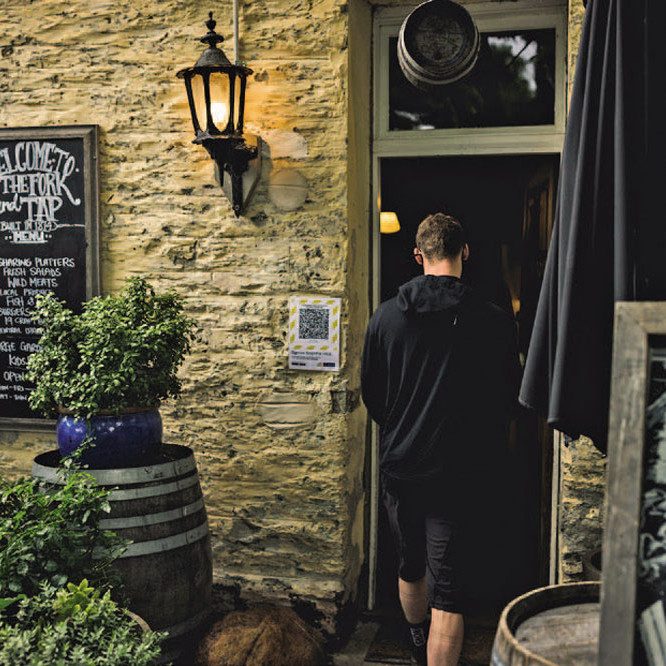
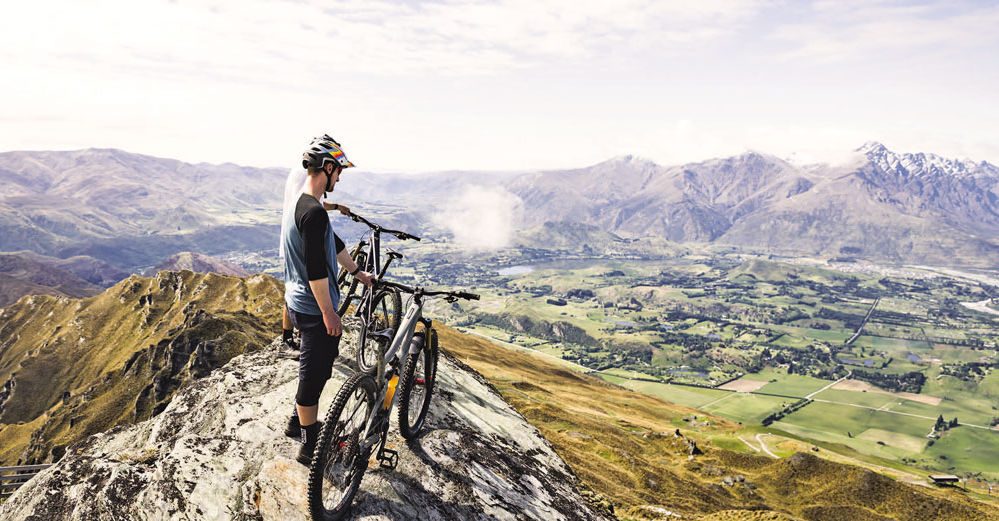
After trying out some over-under lines on a new mega- turn lower down on the trail, we cruised down the denser lower section and out to Arrowtown. The much-needed lunch spot of choice was the Arrowtown Bakery where we got into the selection of pies, ‘footballs’ and cakes on offer. Then it was back into Reece’s van and up the Coronet Road once again to get the afternoon underway.
Originally, we’d planned on riding another one of Queenstown’s newest great trails in the form of ‘Upper Rude Rock’. Wet conditions once again messed with our plans, leaving the trail too soft to open, meaning we headed straight to the existing classic, ‘Lower Rude Rock’ instead. Scenic turns, scenic straights and high speeds are all par for the course down Rude Rock, on the way down to ‘Pack, Track and Sack’. A few fun fadeaways and turns later we found ourselves in Skippers, waiting for the heli.
This was a pretty big highlight of the trip – especially as it was the first proper heli-biking trip for Reece and I, and involved an epic flight up out of Skippers to nearby Bowen Peak. Even if you’ve been in one before, the excitement of a helicopter flight never really goes away, especially in an area that scenically stunning. Run by Helibike NZ, the ride had us dropped off at the top of Bowen Peak before descending on some fresh track to Ben Lomond saddle, Missing Link and Beeched As.
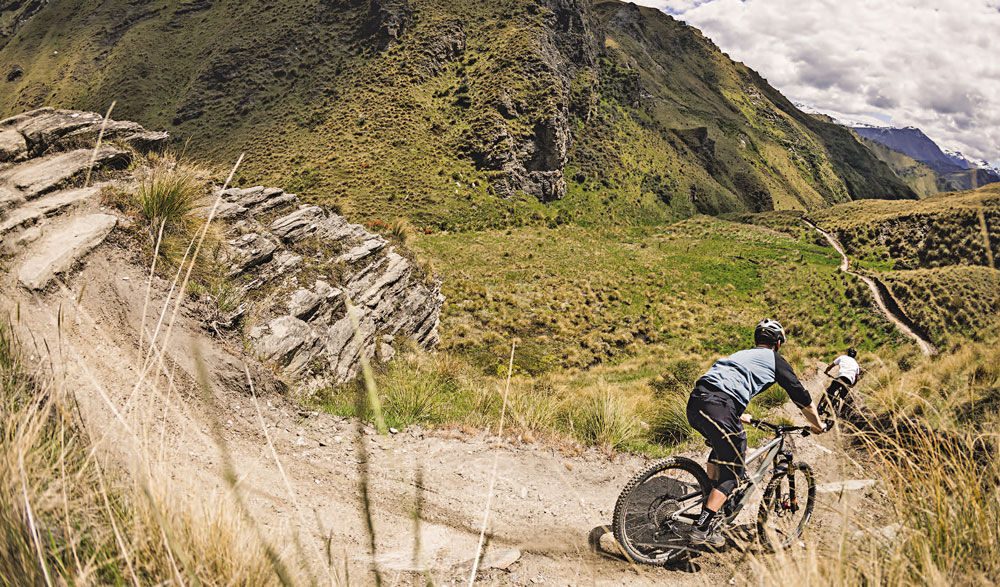
Feeling the pedal around the rest of Beeched As, after being out for quite a few hours by that point, we were hanging for the final descent back to town. Fortunately, we were treated to some epic late afternoon light out on the open part of the Fernhill descent, before plunging into the darkness of the trees. Near the bottom, we got to sample an unplanned freshening of lower Salmon Run, courtesy of heavy rain over the last two days. Although it’s something you usually wouldn’t want to happen, much of the lowest section now runs down the creek bed. This offers a few different line options and plenty of cool rock features to enjoy.
Finishing off the run with recent addition, McNearly Gnarly, and a Queenstown classic in Wynyard DH, we headed down to Atlas to cap off an epic day.
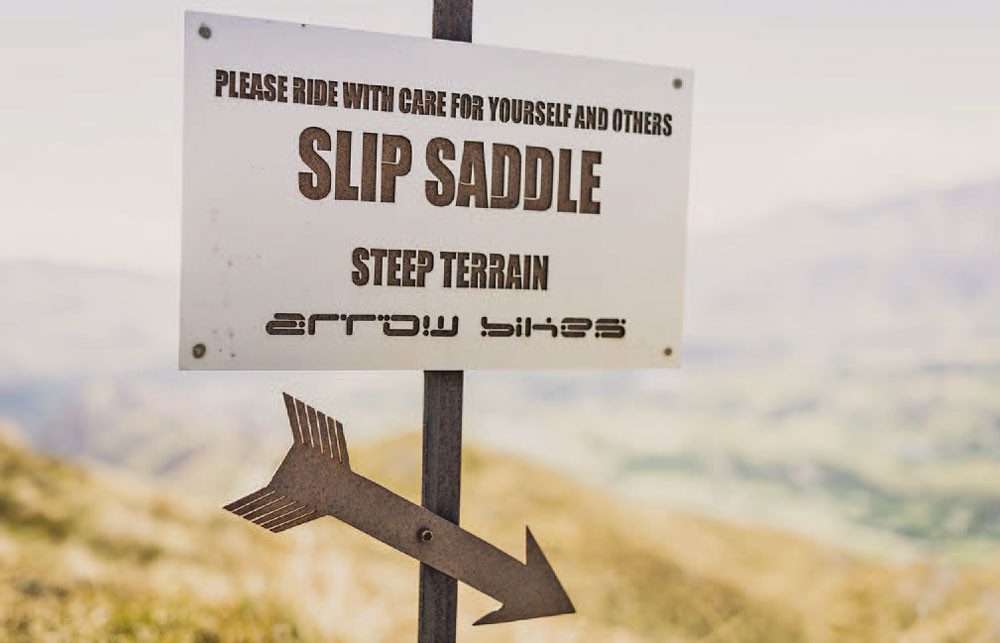
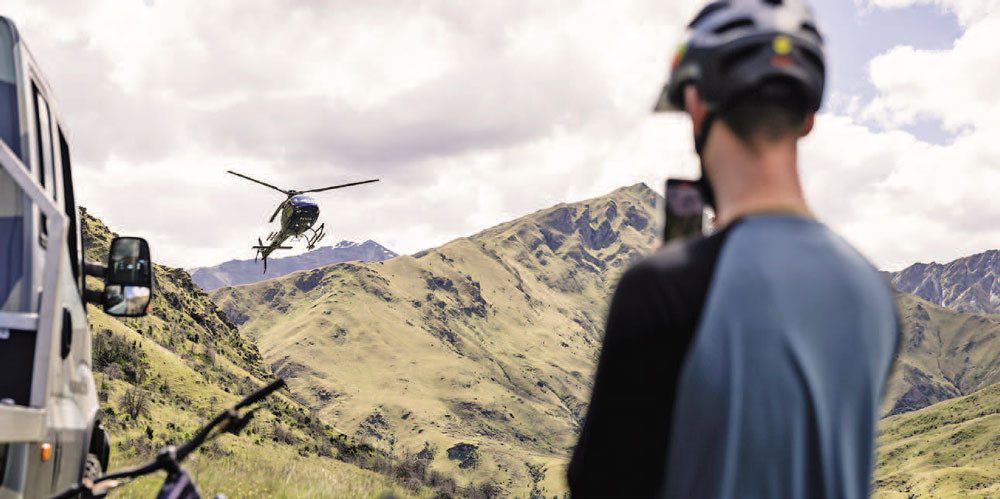
ATLAS
Finishing off a long day of riding down by the lake, with some good food, good people and one of the many great beers on offer at Atlas, is pretty hard to beat. Atlas has long been a big supporter of mountain biking and the mountain bike scene in Queenstown, through a whole raft of activities ranging from sponsorship and donations to the Queenstown Mountain Bike Club (QMTBC); sponsoring or hosting local riding events, like Season of Shred; to hosting end of season parties. A great example of this is the raising of more than $16,000 for the mountain bike club during the 2020 Season of Shred fundraiser.
Good relationships with local businesses like Atlas, and the support that they bring, has always struck me as something that QMTBC does really well. This kind of relationship and support really helps to strengthen that sense of community and the role that riding plays in it. Not to mention the activities, including trail development, that the club is able to undertake because of this support that helps to keep the scene progressing.
After going from hungry to full in a short space of time, we attempted to ride back up to the hotel to drop off the bikes before taking a sunset cruise back up to Coronet Peak to pick up the cars. There are definitely worse places to find yourself at 9:45 on a warm summer evening than up at Coronet Peak watching the basin glow in the fading light.
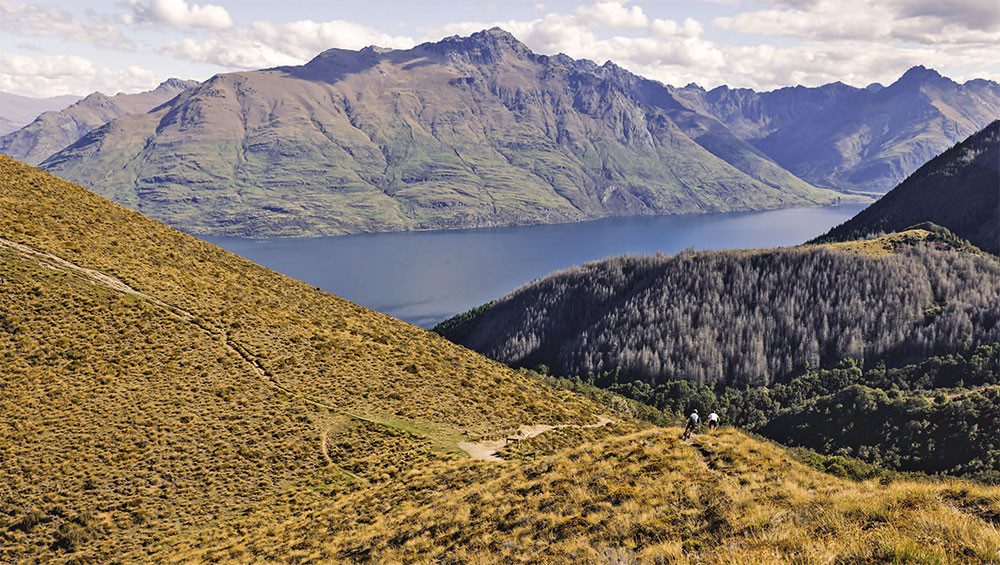
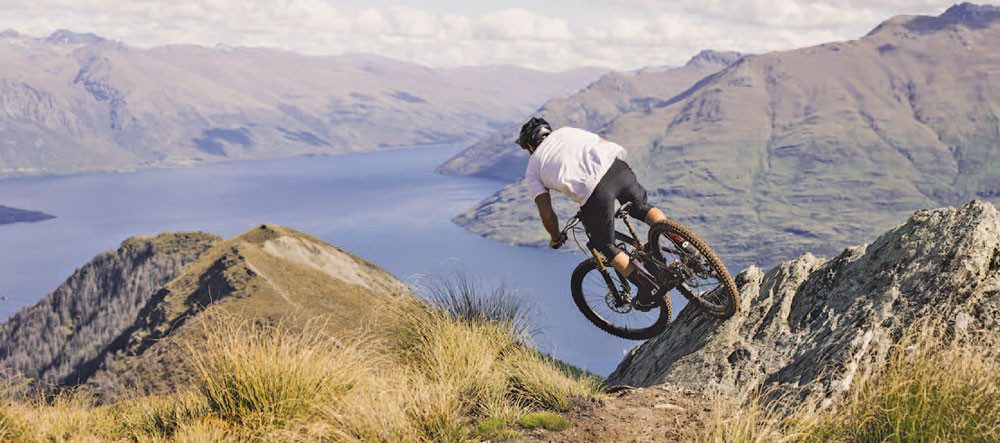
7 MILE
After the sizeable outing the previous day we were feeling pretty spent, so a cruise around at 7 Mile to check out some of the new trails was the perfect choice. Despite having been around for a while, 7 Mile hasn’t missed out on its share of the recent trail developments around Queenstown. The new Buck Land trail is the most recent addition and features a huge amount of impressive wooden features, as well as some nice natural chutes. The trail is another great example of the riding community, with support from local businesses like Altitude Brewing, getting together to build something new and different for the benefit of the local riding scene.
Once we’d checked out the range of features on offer on the new Buck Land trail, we headed down through the flowing jumps of Kachoong and Jack B Nimble. Both trails received a refresh in 2020 and offer a miniaturized bike park style alternative to a lot of 7 Mile’s more natural singletrack options. Dropping down Satan’s Corridor found us back at the lake front and ready to head back to town.
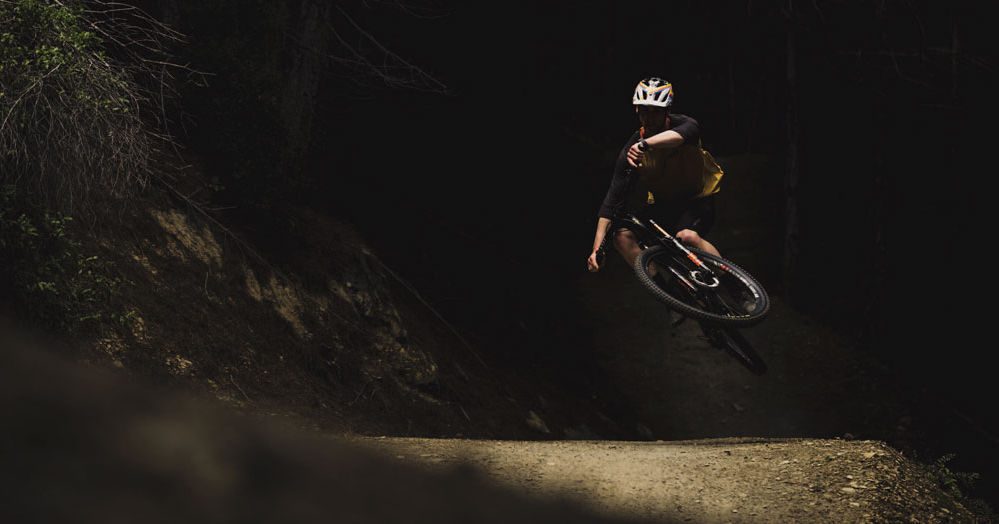
ALTITUDE, CANYON AND WRAP-UP
Our final afternoon saw us finish off the trip by checking out a few more Queenstown breweries. The first stop was at Altitude Brewing, another big supporter of the QMTBC and the mountain biking community. Having already been fans of Altitude’s beers before this trip, we were keen to visit the tap room and see what beers they had on offer.
After choosing from the varied options on the beer list, we had a chat with Altitude General Manager, Peter, who filled us in on the brewery’s identity and their community initiatives. Like Atlas, Altitude has been a big long-term supporter of the QMTBC via sponsorship and donations and even had a couple of QMTBC contribution awards on display in the tap room. Peter also explained to us that since its inception, Altitude has committed to donating a share of beer sales to a range of community organisations and groups, such as the Kea Conservancy Trust and QMTBC.
In a similar sense to Searchlight, Altitude prides itself on being a great community meeting place where people can come down and hang out in a relaxed atmosphere. With the brewery being visible from the tap room, and old kegs used for seating, there’s a nice sense of getting the product straight from the source. Peter told us that this down to earth community atmosphere, coupled with great beer, are core values for Altitude and something they always strive towards.
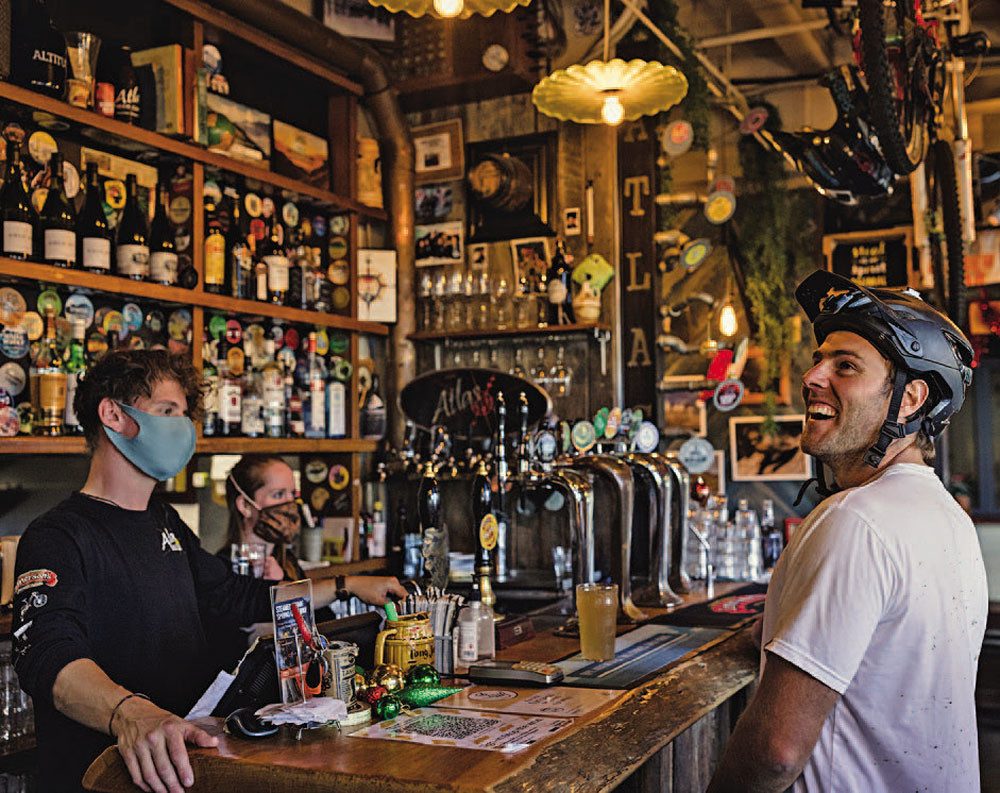
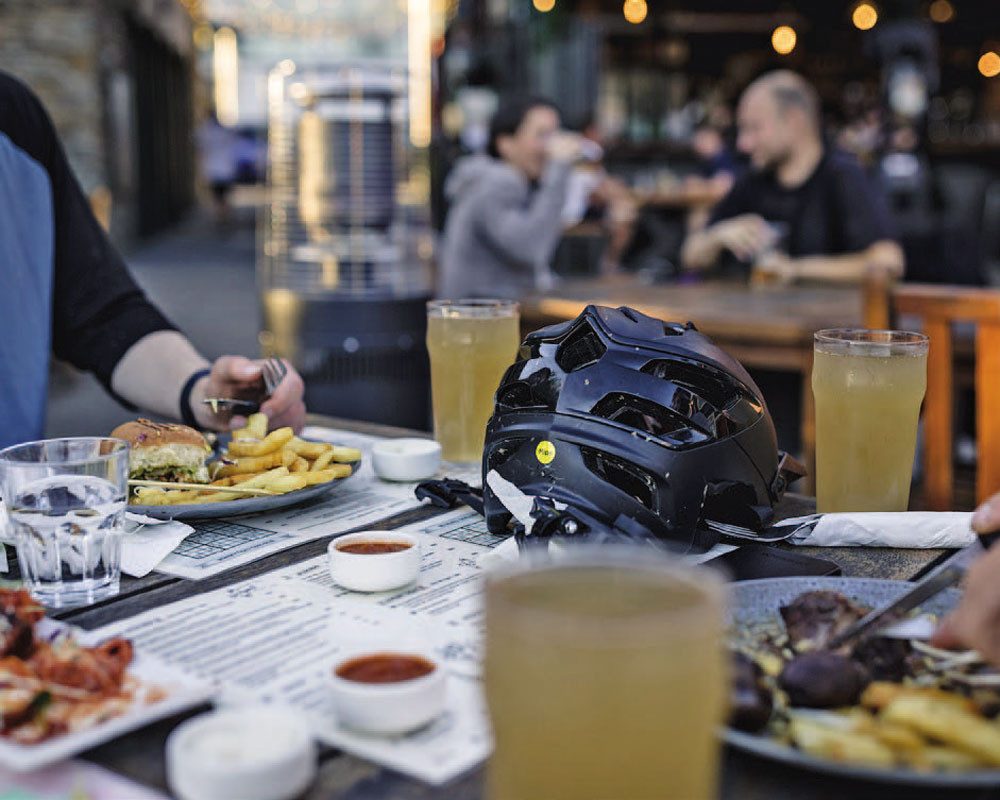
To finish things off, we cruised out to Arthur’s Point based Canyon brewing, sitting right next to the Shotover Jet. Relaxing in the sun in Canyon’s beer garden, with pizzas and a pint, was a nice way to finish off the trip. With so much great riding, backed up by a strong riding community and supportive local businesses, it’s easy to see why so many people are drawn to Queenstown as a riding destination. At the end of each trip, you always leave knowing that the next time you visit there’ll probably be another epic trail to ride or fun jumps to hit. It’s that kind of progression and development that keeps you coming back for more. •
• Thanks to: Destination Queenstown, Holiday Inn Express and partners.
Words: Nathan Petrie
Photography: Cameron Mackenzie
Review: New Earshots
Listening to music while riding can be pretty polarising. People are either really into it: welcoming the addition of tunes to their riding experience, either hyping them up or calming them down depending on the trail at hand; or they prefer to hear the uninterrupted noise of their bike gliding across the terrain, saving all their headspace for the task at hand rather than drifting off, following the music, or podcast, to a different place or time. Of course, then there are those people with a boom box wedged in a bottle cage whilst out in the forest….don't be one of them.
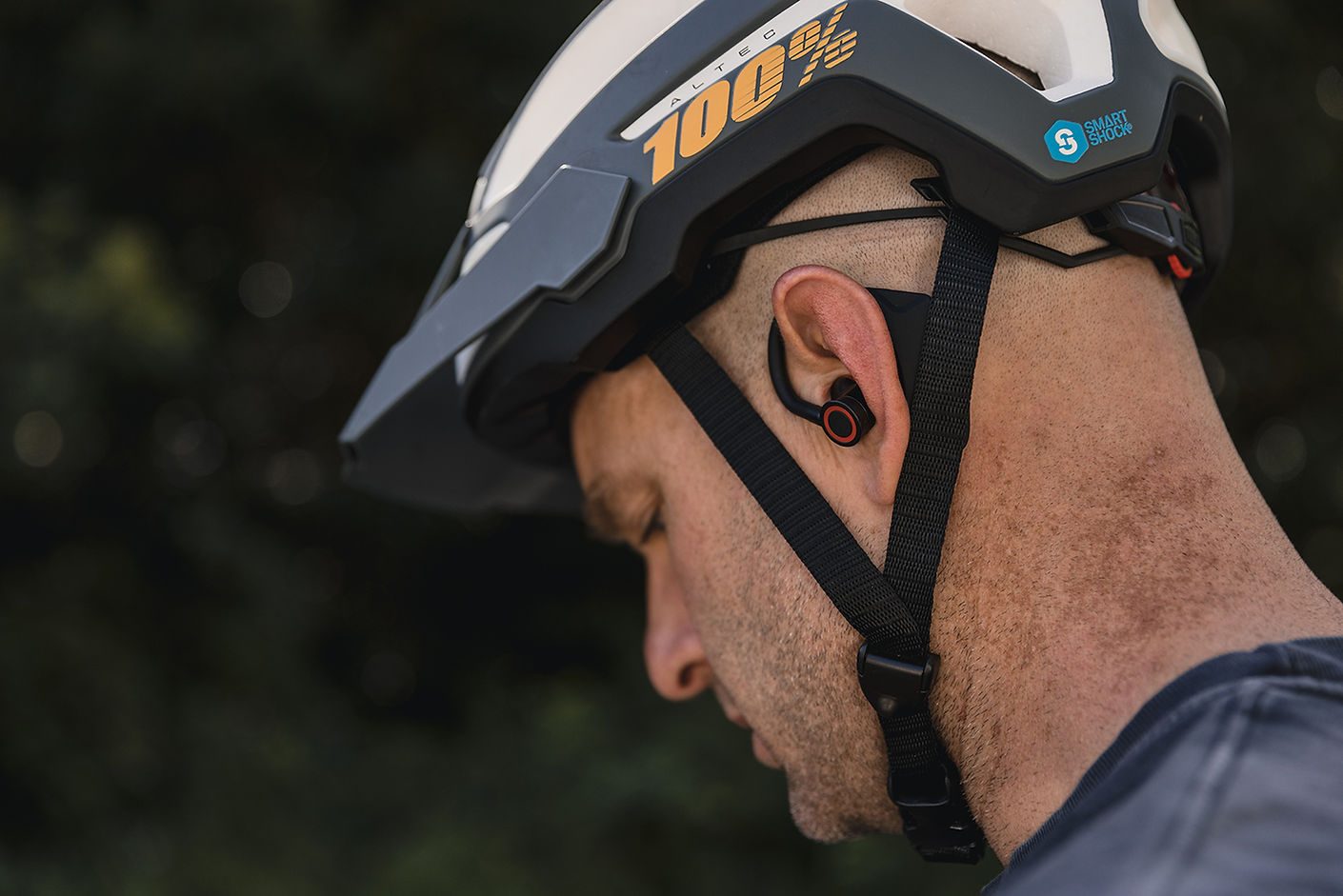
I sit somewhere between the aforementioned camps, preferring the whooping and hollering of my riding crew when there are a few of us or, if I'm solo (which I am for the majority of my riding) it's a single earbud, with the spare one winding around a helmet strap to stop it swinging up and slapping me in the face.
Although I've ventured into the Bluetooth earphone world before, it's always been a struggle to tick the necessary 'boxes', so I keep reverting back to the white wired classics. What am I after? First off, they need to bang – like slap, you know, not distort under the pressure of a heavy bass line, but also stay crisp at the higher clean notes; they need to stay put while riding; they have to allow just enough of the outside world in; they must be comfortable enough and have enough battery to wear for long periods; they need to operate as singles (rather than requiring both sides to be 'on'); and, just as importantly, they shouldn’t cost too much because, well, who knows what's going to happen while you're out riding. I'm not really asking for much, am I?!
Just when I'd all but given up hope of being able to find my ideal riding earphone, in rolls the Kiwi-designed and owned Earshots. I started noticing a slew of new online ads about them and saw that a handful of Kiwi riders had been added to their team. My initial interests piqued again and, days later, I landed a pair of the newly released Generation 2 Earshots. The game changed, and I wondered if maybe I’d just found the solution to my audio issues?
Presented in completely redesigned and recyclable cardboard packaging, the Earshots keep it clean and simple. Everything you don't need can be tossed straight in the recycling, leaving you with a charging cable and the industrial-looking case containing the actual earphones (which also doubles as a charging dock) and nothing else.
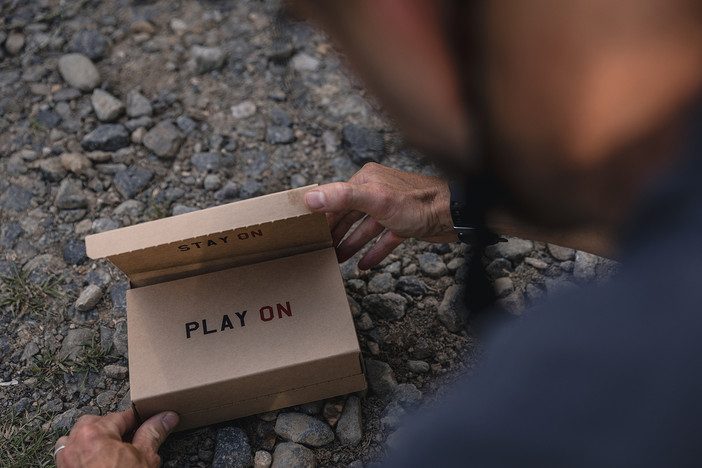
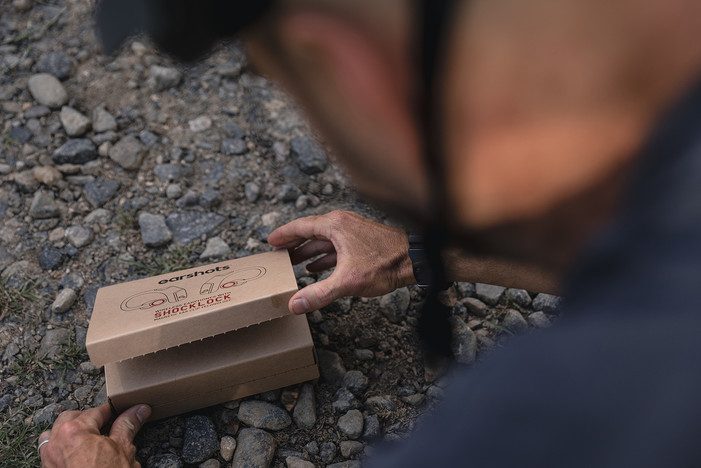
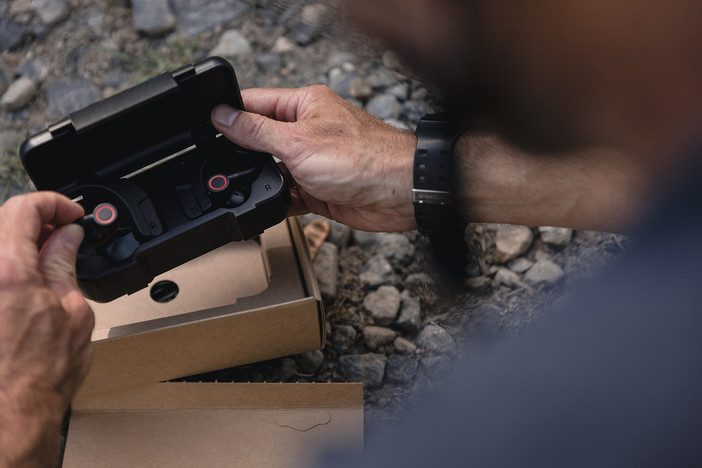
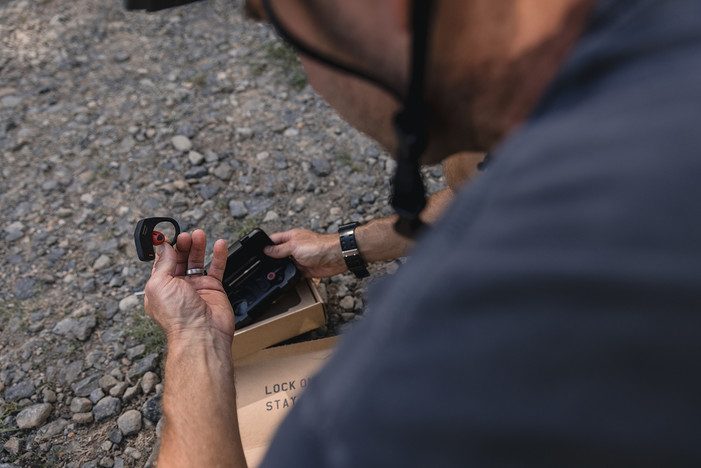
Like every other classic Kiwi bloke, I ploughed in sans instructions and after enough trial and error, but no swearing, I got them to fit correctly. Once they were on my ears, I figured I may as well read the instructions to see if I’d missed anything of note. The packaging has brief, but concise, instructions printed on it but that had already been ditched in the recycling bin, so a quick Google and, voila, I was deep in the Earshots website reading step-by-step instructions on how to fit them easily (unlike how I initially fitted them). I absorbed a few more operational details, sussed what the button on each unit did (skip track, pause, take a phone call) and I was ready for some tunes. The lesson here is: save yourself some time and read the instructions first!
The ‘Shocklock’ magnetic clip comfortably locks the earphones in place and gives you confidence that they're not going anywhere. The magnet isn’t noticeable, just a gentle hug of the ear and they're staying put. Simple adjustability means you can tailor the bud angle to suit the shape of your ear and ensure a secure yet comfortable fit.
My phone was out of reach (playing 'Twinkle Twinkle Little Star' on repeat to get the kids to sleep - true story!) so I synced up to my laptop, cracked a coldie, opened YouTube and dove headfirst into an evening-long YouTube music wormhole. I started off with some Radiohead (In Rainbows Live From The Basement), and ended up with some Rage Against The Machine (The Battle of Mexico City) via Kendrick Lamar (King Kunta), Bon Iver (at AIR Studios 4AD/Jagjaguwar Session) and a bunch of other varied classics – see the full playlist below. This was a sufficient and eclectic mix to confirm the Earshots ticked the box when it comes to audio quality and pure sound pleasure.
When I’m not on the bike, I usually enjoy tunes on the over-the-ear headphones from the ‘Billionaire’ brand, for the full experience. Unfortunately, they're no good for any activity other than sitting still: on the stationary bike they get drenched in sweat, at the gym they fall off, and it's impossible to wear them mountain biking. But none of these are issues you'll strike with the Earshots. From a riding point of view, they do what they say on the box: they stay put regardless of how hard you’re “shralping”.
I'm honestly surprised how good the sound quality is compared to my regular headphones, there's not a lot of difference. I'm no audiophile but I know ‘good’ and ‘bad’ sound. Kendrick Lamar's 'King Kunta' has a deep bassline and the Earshots allowed it to truly shine where inferior units would crackle and pop; they certainly lean towards the more ‘bass-heavy’ end of the sound spectrum but, to be fair, that's what most of us are after when out riding, right?! The added bonus over many modern earphones, is that these don’t seal off the outside world completely, allowing some ambient sound to make it through to your eardrums.
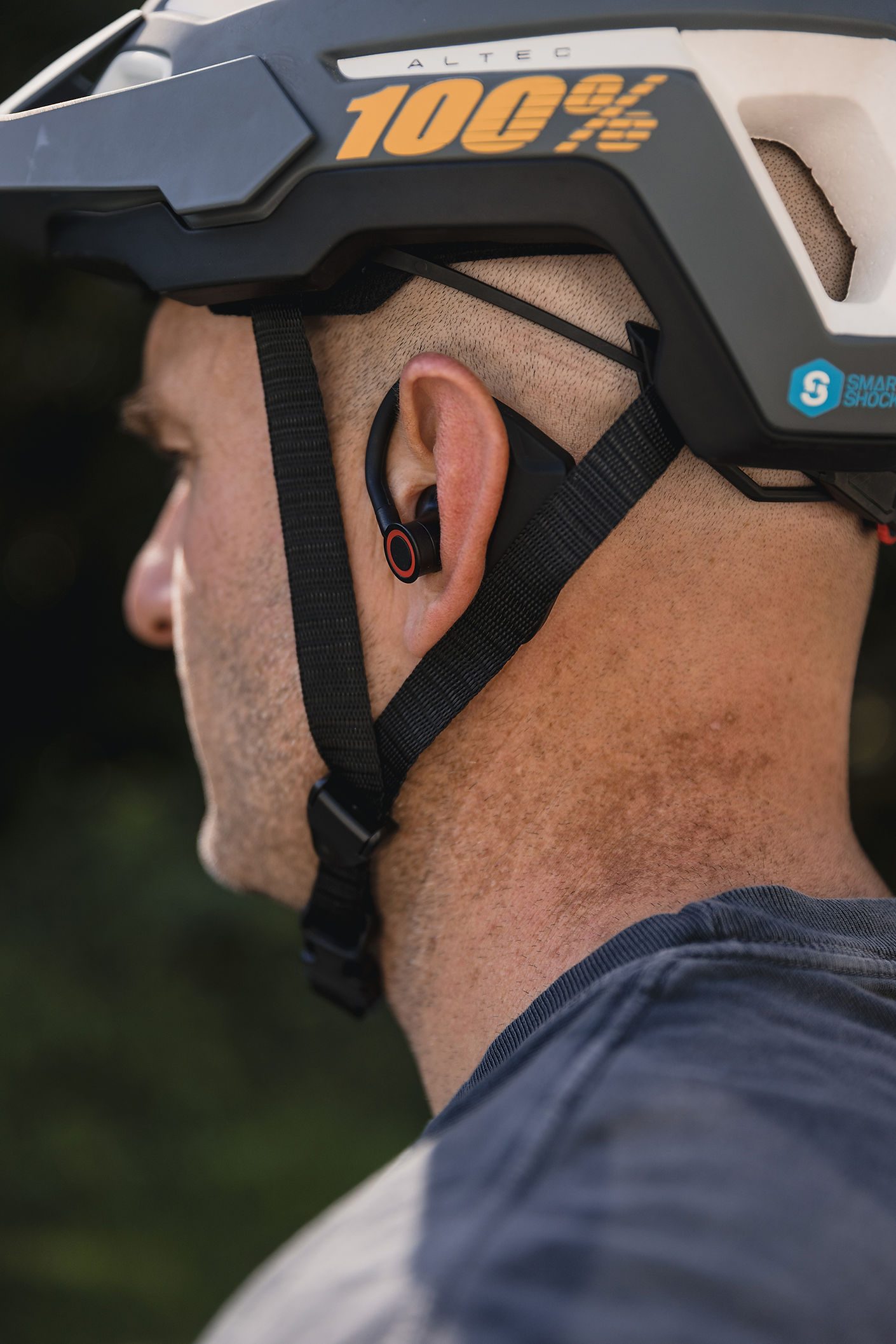
While the Earshots have become my go-to earphones when doing any activity, they do have some small (but not deal-breaking) niggles. Getting them to sit just right on your ears does take some time to get right, the more you do it, the easier it becomes but they're not as simple as regular earphones to just throw on. The case does a great job of protecting the earphones, and recharging them while not in use, but it's pretty large. That's not a biggie if you're out for a normal ride, as you'll have ample battery life to get you through, but if you're on a multi-day, off-grid bike adventure (i.e. bikepacking) then you'll need the charging capability of the case, and if you're packing ultra-light you probably won't have room for it. I do wonder if the brains of the Earbuds, which sit behind each ear, might come into contact with some helmet straps depending on model and size? This is not something I’ve come up against personally, but might be worth keeping in mind. The only other feature which would be handy is a volume control on the earphones themselves, rather than needing to fish your phone from your pocket.
The bottom line is, if you like to ride with music or podcasts and you're still rolling around with wires between your device and your ears, you're missing out on the freedom, security, and audio quality of the wireless Earshots. Ditch the wires… even derailleurs are doing it these days.
Suggested bangers for your Earshots:
Radiohead - In Rainbows Live From The Basement
Shy FX - Roll the Dice ft Lilly Allen
Protoje - Who Knows feat Chronixx Shy FX Remix
Dub FX & Stamina MC - Only Human
MEUTE - You & Me (Flume Remix)
System Of A Down - Toxicity Live from BDO 2002
LCD Soundsystem - Someone Great (Live on Austin City Limits - Web Exclusive)
Bon Iver - Full Concert | NPR MUSIC FRONT ROW
Rage Against The Machine - The Battle of Mexico City
Distributed by Earshots
Reviewed by Lester Perry
Review: 100% Teratec Plus Elbow Pads
“I managed to avoid hitting any trees with my elbows, but with these on, I’m kind of tempted to give one a nudge anyway.”
Buying elbow pads is a bit like buying health insurance; you probably don’t really want to spend your money on it but, the moment you need it, you’re sure glad you did. 100% have a massive array of mountain bike specific protection on offer now, with four unique ranges depending on whether you like the full-on Iron Man level of protection, or something more understated that would fit in well at your local yoga class. Somewhere in the middle of all this is the Teratec+ range, and I’ve been putting the Teratec+ elbow pads through their paces for a few months now.
The Teratec+ are a full-sleeve style elbow pad. There are no straps or Velcro, just a stretchy mesh on the inner forearm and padding on the outer. The elbow pad is naturally curved, articulating just above the elbow which means that it moves nicely with your arm, without any pinching or bunching.
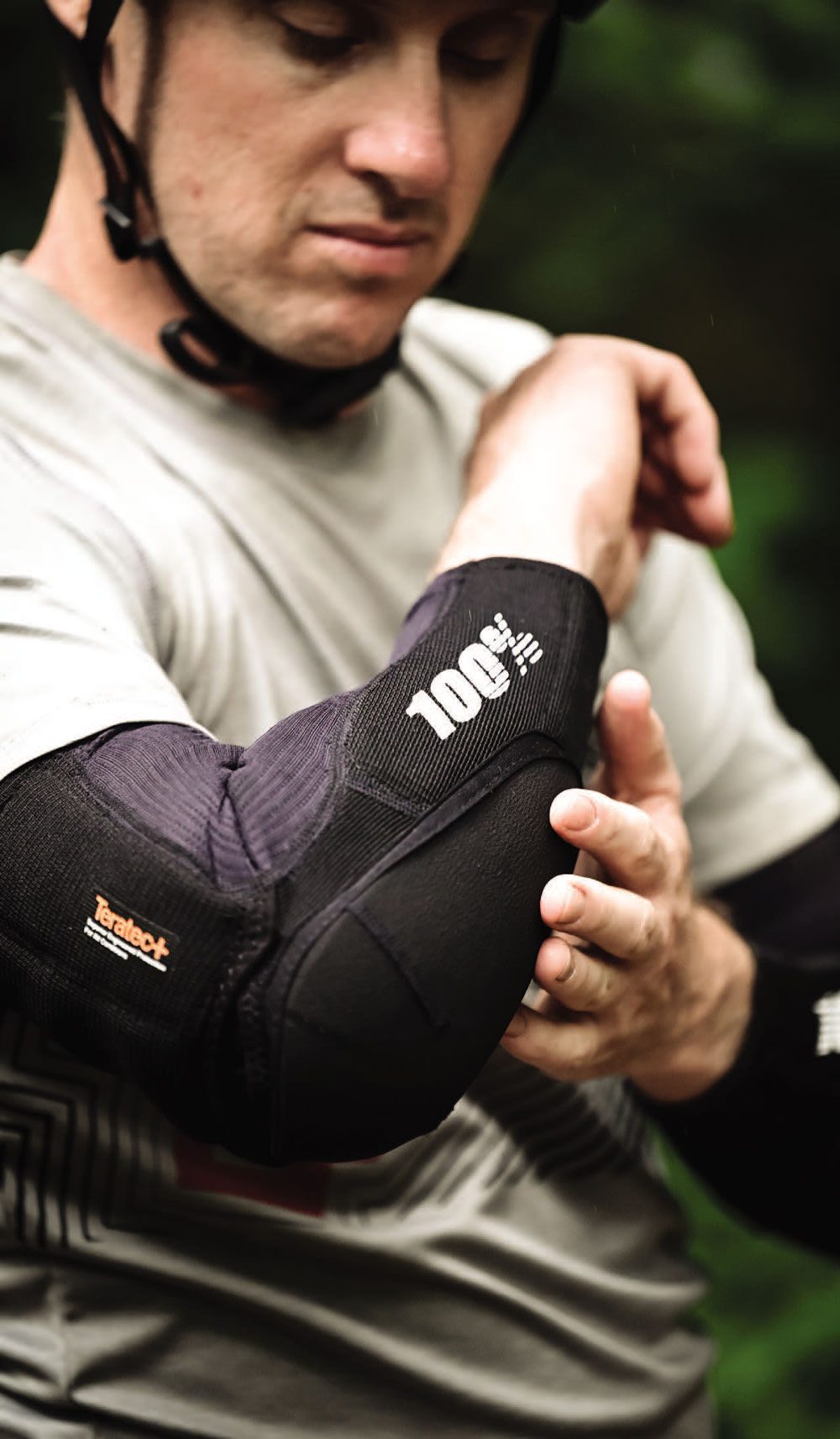
The main padding on the elbow and forearm feels a little like the G-Form style soft, putty-like, slow- rebounding material. Extensive googling couldn’t help me find out anything more about this but suffice to say, it feels sufficiently thick to stop the hardest of impacts.
Above and below the main line of elbow padding is a thinner foam pad, extending the protected area around your forearm as well as up and around the triceps area.
They feel like the most coverage and protection you can reasonably expect from an elbow pad that doesn’t utilise a hard plastic shell. Personally, I prefer pads without the hard shell as they seem to still offer ample protection for 99% of the scuffs that my elbows face, and get the benefit of increased flexibility and ability to form to your arm. There is also a band of silicone grip at the upper cuff to stop them sliding around.
On the trail the Teratec+ elbow pads felt great. The bend in the elbow feels just right and, after a few moments, I tended to forget they were even there – ideal really! The full-sleeve style is undoubtedly a hotter style pad than something that is really only covering a protruding elbow, but it does give a boosted sense of confidence on the trails. Riding in the spring and autumn, when temperatures are just a little bit cooler and the trails a bit more slippery, I think I would find myself wearing these frequently. The sleeve style helps them stay in place and they do a great job of not budging – even over the roughest terrain – without feeling restrictive. As luck would have it, I managed to actually avoid hitting any trees with my elbows during the review period but, with these on, I’m kind of tempted to give one a nudge anyway.
REVIEW: LANCE PILBROW
DISTRIBUTOR: FE SPORTS
RRP:$139
Feature: From Birth to Evolution
Four Forty Mountain Bike Park enters its sixth season of operation in 2021.
Back in November 2014, backing onto the Hunua Ranges just south of Auckland, in a previously little-known part of the North Island (for most serious mountain bike trail connoisseurs), Four Forty Mountain Bike Park opened to the public for the very first time. Fast forward to October 2021 and the park is entering its seventh season of full commercial operation.
The project, originally headed by Byron Scott and Aaron Tait – before Byron bought out his business partner in 2017 – has seen many iterations. Most recently, there has been trail work completed by Trailpro and sizable investments made in park infrastructure, in preparation for this coming season. In recent years, the park has been through its most visible changes largely due to pine harvesting, as the park operations are undertaken on a fully operational forestry block.
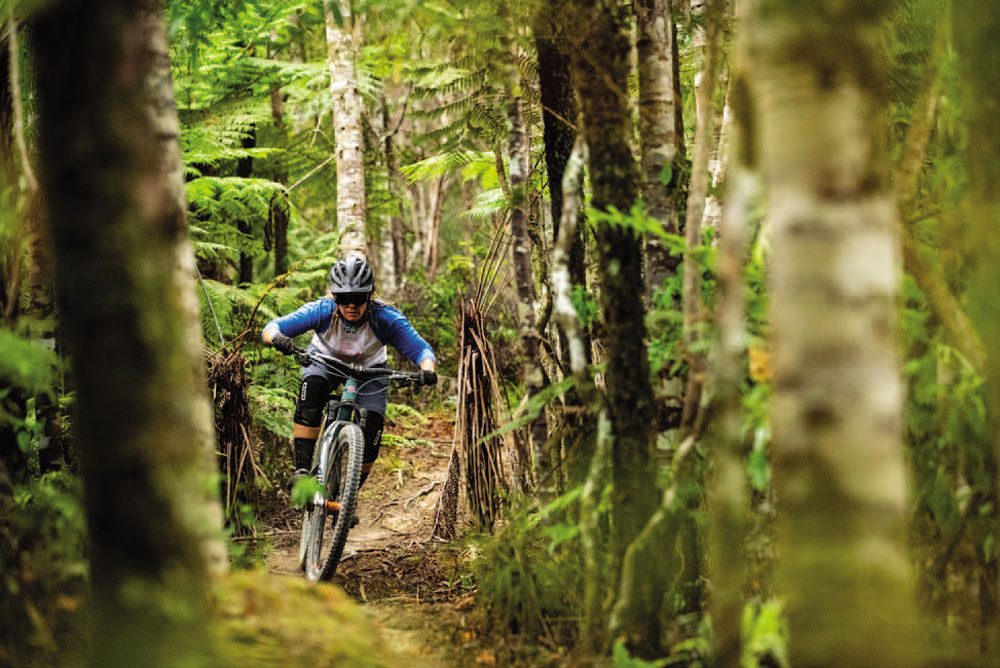
Not to worry – there is still plenty of lush native forest and pines to accommodate your party in the woods. Due to clear felling in sections of the park in the winter of 2019, several of the original trails have been fully rebuilt including Pretty Fly which, overlooking the Hauraki Gulf and the Firth of Thames, surely has the most spectacular jump lines in New Zealand.
Park developments are not limited to the trails. This season, substantial investment has been made at the base area. Previously, the park ticketing office, retail, workshop and bike rental was all run out of several well-dressed containers. What was a little too rustic to be safe for public use, the sheep shearing shed has been replaced by a much more permanent 150m2 building, including an office and retail space larger in size than most dedicated urban retail spaces. The character of the old sheep shearing HQ has been thoughtfully maintained, with a nod to the land’s previous commercial uses. This asset signals the permeance of the park and Byron’s intention to continue to improve all aspects of the customer experience. Surrounding the base building, over 4000 native plants have been placed as evidence of the thought and care that has gone into all aspects of the park’s current existence.
It has been no easy feat to reach this level of development in just six years with nothing but private investment from Byron himself, and with support from enthusiastic landowners who allow this activity to take place on a fully operational forestry block. It has been Byron’s enthusiasm for mountain biking, quality trails and seeing diehard customers return to the park to ride year after year that has fueled the efforts required to open and operate the park each season. In the early years, customers trickled though the gates and many issues with the management and operation of the shuttle vehicles put barriers in the way of consistent growth in the business. But, having spent so much time and personal money on the venture – to the point that Byron’s perseverance, coupled with a will to solve or work around issues that arose, is what eventually pushed the operation through the challenging startup years. Byron compares the journey to a crawl across the desert; “you are halfway across the desert – what do you do?”. It is this bullish approach, combined with Byron’s creative problem solving, that results in an approach to life and business for him that most would shy away from.
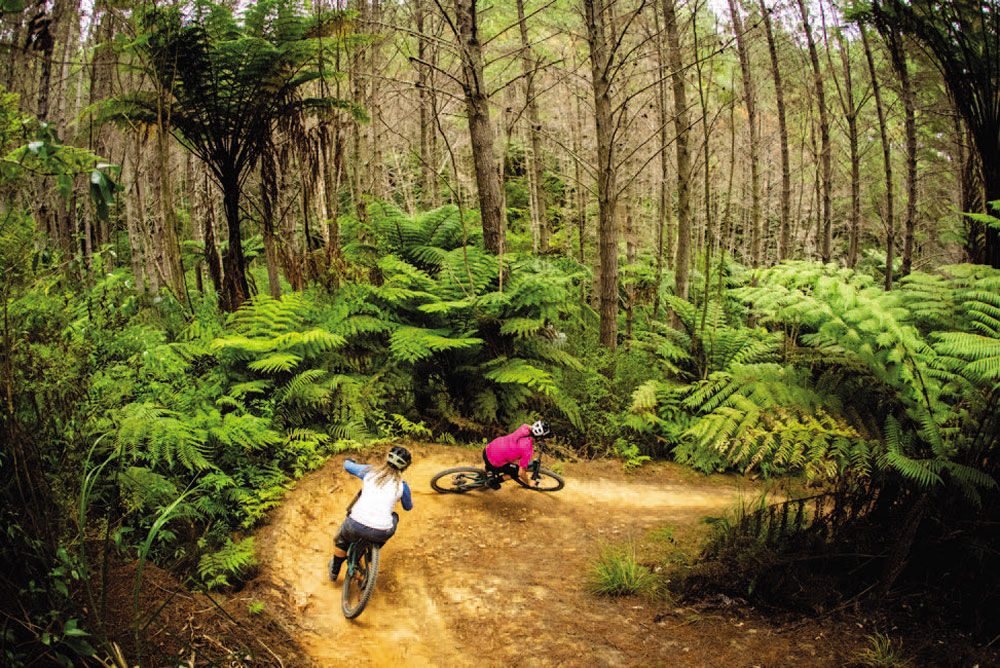
Once the formal years had been navigated, the key to the park’s growth — which has enabled the continued development towards entering this next phase for the business – has been the trail quality. When the park first went into operation, there was just six km’s of trail. Today, 22km of trail exists in the park, with a variety of trail styles and grades - the quality of which is rivaled by few commercial bike parks globally. The attention to detail in the construction of the trails – and, as a result, the ride experience for the customer – can only be described as a true feeling of flow. This is what keeps the core local and regional customers coming back and is now starting to attract users from an increasingly wider geographical area.
From narrow, off camber hand cut lines and a national downhill racetrack, to fast flowing digger- built lines and flowing jump lines, the park has evolved significantly. In the context of running a commercially sustainable bike park, it’s not just the trails alone that contribute to the overall experience of the customers; Byron believes this is the single largest contributing factor to attracting repeat business.
It’s not just the quality of the trails that bring riders from far and wide; Four Forty has been home to a swathe of national and regional events since day one, including Auckland Downhill Champs, National Cross Country and Downhill Series rounds, the annual 440 Gravity Enduro, National Secondary Schools champs and, of course, none other than the Dodzy Memorial Enduro.
The kickoff to the 2021 / 2022 season was delayed due to the recent Covid lock downs. With the park fully polished and ready for opening in September the momentum of park trail crew, and staff had to be redirected temporarily.
In true 440 spirit the situation was managed, plans were changed, and they made the best of the situation by distracting themselves and their customers by posting humorous content to their social media channels and by building their new fleet of Transition rental bikes.
The park was finally able to open for the season on the 10th of November albeit at reduced capacity to comply with current operational restrictions. Needless to say, the staff are happy to serve the customers and the customers are happy to be back riding at one of the best niche gravity riding locations New Zealand has to offer.
• Located a leisurely 50 minute drive directly east of Auckland Airport – or rather, 2 hours 45 from Redwoods – Whakarewarewa Forest, Rotorua – for the mountain bikers of New Zealand.
Words: Cam Cole
Photography: Sven Martin
Review: Trek 2022 Top Fuel
“The Trek 2022 Top Fuel responds really well to rider input and, as a result, is simply really fast.”
The process of evolution involves a series of natural changes that cause species to arise, adapt to the environment and, sometimes, to become extinct. From walking on two legs to riding bikes and now having the ability to ride bikes off cliffs at Redbull Rampage shows how far we’ve come!
Just like us, bikes tend to evolve too; the Top Fuel we’ve had on review for the last two months is a perfect example of that. Previously Trek’s XC race bike that evolved into a marathon bike, it has evolved again, and Trek fans might be wondering just what exactly the new Top Fuel is now?
Trek’s Supercaliber, with exclusive IsoStrut shock, 60mm of travel and unique pivotless seatstays, sits in the XC race seat the Top Fuel used to occupy in Trek’s stable. This has given the Top Fuel the opportunity to evolve out of that same XC space into something new, and that’s exactly what it has done.
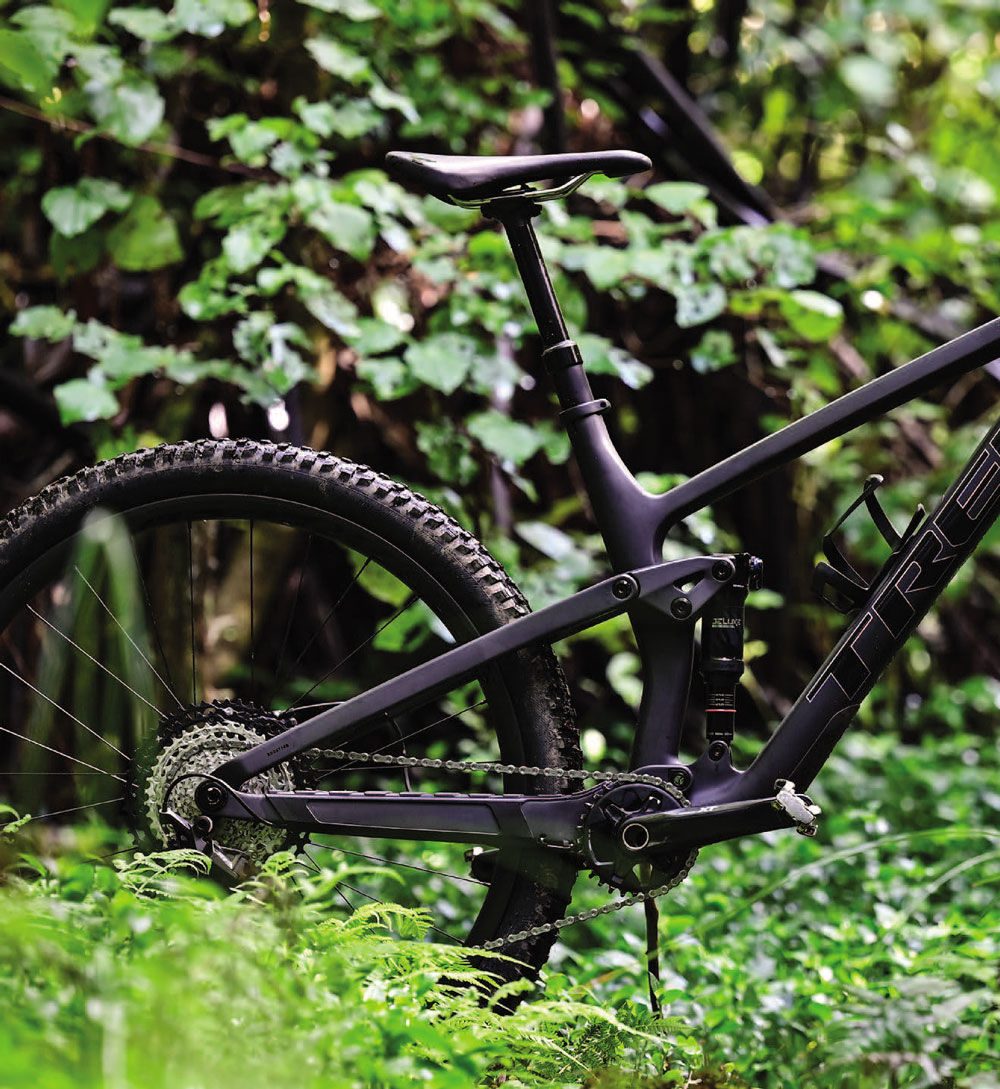
So, is it a ‘trail bike’? Is it a ‘down country bike’? Or is it just what we also thought a ‘mountain bike’ was?
Previous Top Fuel fans might even be asking, ‘has it evolved too far?’
In New Zealand, the Top Fuel will be available at eight price points. As mentioned, we’ve had the 9.8 XT model, worth $8849, but it’s also available in two alloy models which offer the most affordable entry points; the Top Fuel 5 at $3799. Entry into the carbon options is the 9.7 ($6599), going all the way up to 9.9 XX1 AXS Project One, for $15,449.
So, what are the key changes that have been made in the process of evolution? For 2022, travel in the rear ups from 115mm to 120mm.
To be fair, 5mm extra travel isn’t really much of a game-changer but upping to 120mm sends a signal that this isn’t, in fact, a slightly evolved XC bike – this is definitely an all-new Top Fuel. Making all that 120mm of travel work, is Trek’s ABP rear pivot system.
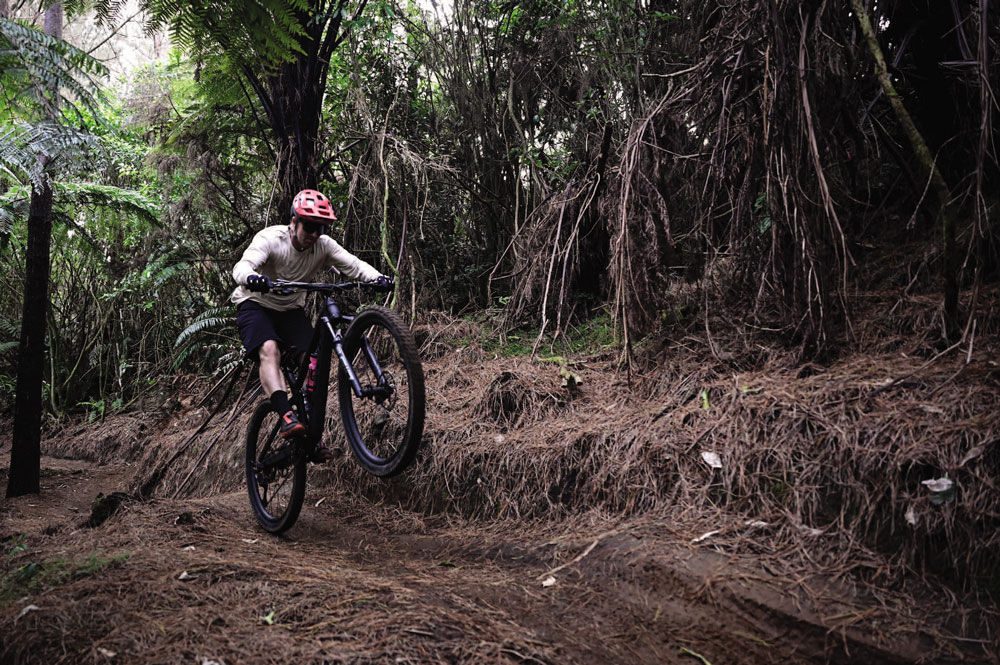
We’ve always been a fan of this system – the rear axle pivot rotates directly around the axle point, and this allows Trek to tune how the suspension reacts to acceleration and braking forces independently.
At the lower shock mount, Trek’s flip chip style geometry adjustment, the Mino Link, lets you fine tune your frame geometry ‘on the go’.
In reality, it’s not likely you’d be doing that out on the trail but in the comfort of your garage, where you aren’t worried about losing precious shock hardware in the dirt, you can flip the Mino Link. Stay in low for a slack 66-degree headtube angle. Flip it for a quicker 66.5-degree headtube angle and a 7mm higher bottom bracket for more ground clearance. All of that is driving the RockShox Deluxe Ultimate RCT shock.
Up front sees the new Rock Shox Sid Select+ 120mm fork. At upward of $8800, we’d really love to see the Sid Ultimate, which gets the benefit of the improved Charger Race Day, over the Charger 2 RL that come on the Select+. However, you still get the full carbon OCLV frame along with Bontrager’s Line Elite carbon wheels, and a full XT build kit from tip to tail, including the superb 4-pot XT calipers and a 10-51 tooth cassette. Everyone seems quite particular about which drivetrain team they are on, so Trek offer their 9.8 and 9.9 models in either SRAM or Shimano build kits.
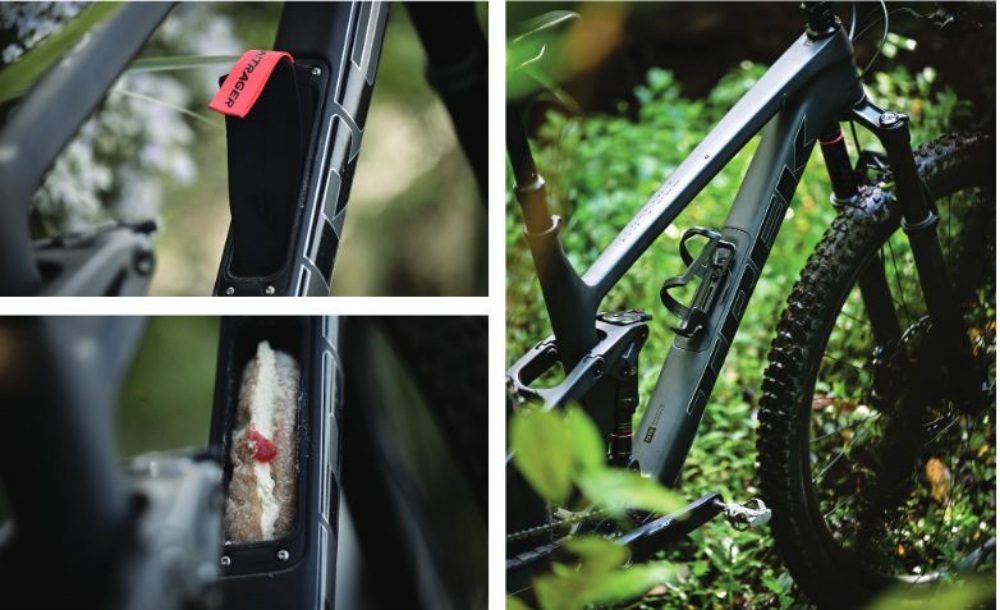
Out of the box, we personally liked the matte carbon look with holographic details around the edge of the logos. It’s subtle, smart and stealthy. This is the cheapest option at the 9.8 spec level. It’s also available in gloss black with a red swingarm, but this is essentially one of their Project One custom paint jobs, and you’ll pay an $1800 premium to get it. That’s some expensive paint.
For us, the pick of the bunch has to be the striking red/purple/yellow fade on the 9.8 GX build. Sadly, that one carries the $1800 paint premium too so will set you back $10,649 total. With all that in mind, the matte carbon XT option looks pretty good. To be fair, the Project One custom paint options that Trek offer are pretty amazing and their paint configurator is also a great way to kill an hour – don’t say we didn’t warn you. It’s cool to see companies allowing this kind of customisation.
All the housing is internal, which completes the sleek look. Your tool kit is also internal! Or it can be, if you want it to be, with a handy tool storage compartment integrated under the bottle cage and a complementary Bontrager Bits pouch to wrap things in. We can now confirm that alongside a small tool kit, you can also squeeze a long cream donut – in case you’re worried about going calorie negative during a ride (who says we don’t do hard-hitting journalism here at NZ Mountain Biker?!).
At the bottom of the down tube there is a plastic armoring to protect the carbon, and a chunky rubberised chain- stay protector to keep things quiet. Trek fans will see the return of the Knock Block, now updated to the Knock Block 2.0, which keeps cables from getting yanked out in a crash and protects the top tube. The only difference being that it now provides an improved 72-degrees of turning radius.
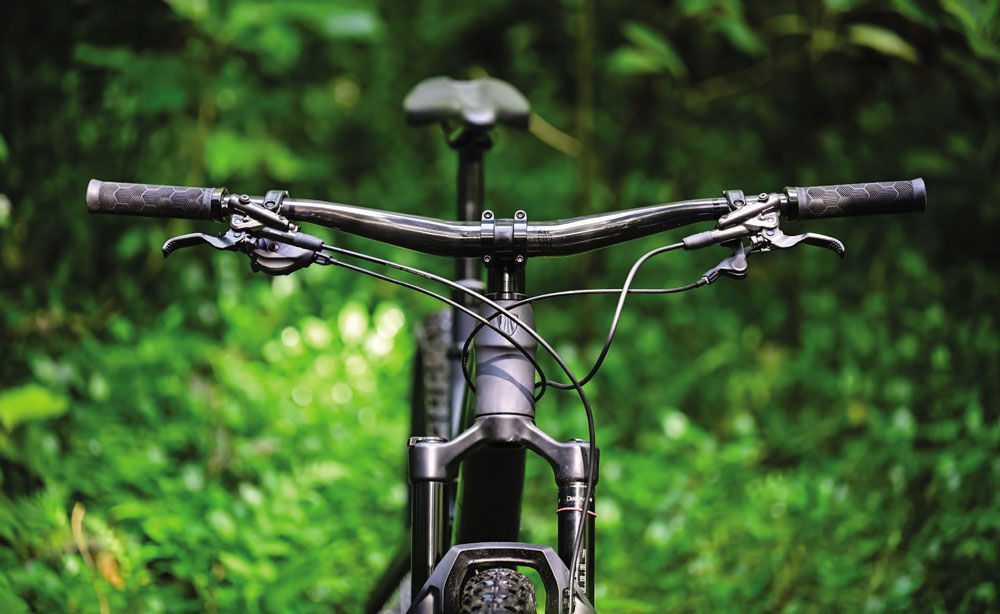
Interestingly, for an XC- ish oriented bike, there is only one bottle cage mount. This seems strange, as this kind of bike seems perfect for longer rides and maybe even marathon races. With 120mm travel, 66.0-degree head angle, and 2.4” tyres, the Top Fuel is set (on paper at least) to be a pretty fun whip and, as we’ve been saying, firmly has its place in the ‘trail’ category. The question Trek buyers might be asking is, ‘is this basically just a new Fuel EX?’ Looking at the numbers, you certainly have to wonder if the difference is big enough? And, if you’re tossing up between the Top Fuel and the Fuel EX, which one should you buy? The Fuel EX is a 130mm travel bike with a 140mm Fox 36 fork. They’ve both got a 66-degree head angle, their wheelbase is almost identical (121.5 for Top Fuel size large, 121.1 for EX) but the reach on the Top Fuel is actually longer (48.0 for the Top Fuel vs 47.0 for the EX). If anything, this probably just signals that the EX is due for a refresh, so we would be surprised if we didn’t see that for 2023, where we expect it will get a similar treatment with a bit more travel and a bit slacker head angle. That will make you wonder if the 150mm Remedy, the last remaining 27.5 wheel bike in the lineup, really has a place any more?
Anyway, all that is Trek’s marketing problems to worry about. Our job is to ride the Top Fuel we have today. Trek describes the Top Fuel as the perfect bike for riders who like to stay pinned both up and down the trail. The term ‘Top Fuel’ is a term associated with American drag racing, which is all about acceleration, so we were expecting this to be a bike that would draw on its XC roots and get up to speed fast – but with modern geometry and tyres that give confidence to push through the corners. Even though we spent two months on it, it didn’t take much riding at all to confirm this indeed lives up to its marketing team’s hype that the “Top Fuel loves to pedal up – lives for challenging descents”. At the end of our review period, we were left thinking, ‘this is the kind of bike a lot of people could be riding’. The Top Fuel gets so much right; the handling is sharp, and the suspension is both active and supportive. It’s the kind of bike that, when you get to the bottom of a rowdy descent and you know you’ve got a decent uphill ahead, you don’t drop your head and wish you were on an e-MTB; instead, you just get on with the pedalling – and might even find you’re kind of enjoying it. Our totally unscientific belief is that, thanks to effective marketing, more riders are riding longer-travelling, heavier, squishier (yes, it’s a technical term) bikes than perhaps the terrain actually requires, and this has really taken the shine off something we are doing a lot of the time, despite what we like to think: riding up hills. Part of this trend to longer travel and overall extra beef, has been about geometry. It has only been longer travel bikes that have had the matching geometry that inspires confidence at speed, or over steep terrain. But, with more modern geometry (read: longer, slacker) trickling into bikes like the Top Fuel, you now have the choice of riding lighter, shorter travel bikes with more confidence over technical terrain. Do you really need 160mm of travel for your everyday ride? Maybe, but probably not. Maybe you’re happy to ride a bike with less travel, but there just haven’t been shorter travel bikes with the corresponding geometry that makes riding downhills a real hoot? This is what the Top Fuel is all about.
Tyre choice can be one of the most significant choices in what terrain a bike will excel on, and with Trek spec-ing the new 2.4” XR4 tyres, they clearly had this in mind. They are noticeably chunkier tyres than you might find on a 120mm travel bike, and probably reflect the kind of personal changes most riders end up making to their bikes in time. The XR4 tyres are worth pausing on for a moment, because they really are a bit of a Goldilocks tyre: not too heavy, not too light – just right. We only mention it because so often tyres seem to just miss the mark. The XR4’s do a great job of hitting just the right balance of speed and control to enable the bike to do what it was designed to do. 2.4” might sound wide but, just like the nation tuning into daily press conferences, it’s the ‘new normal’.
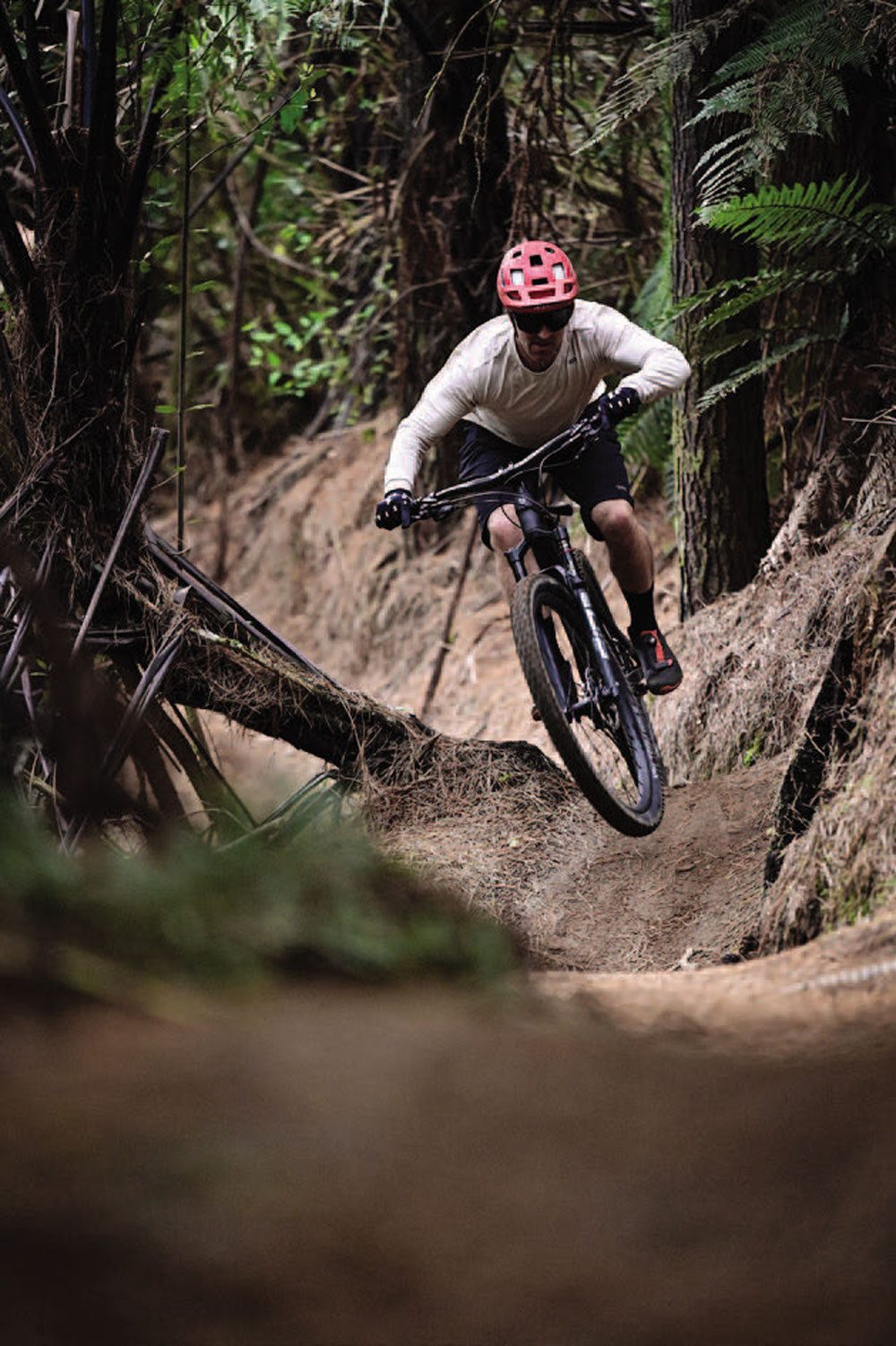
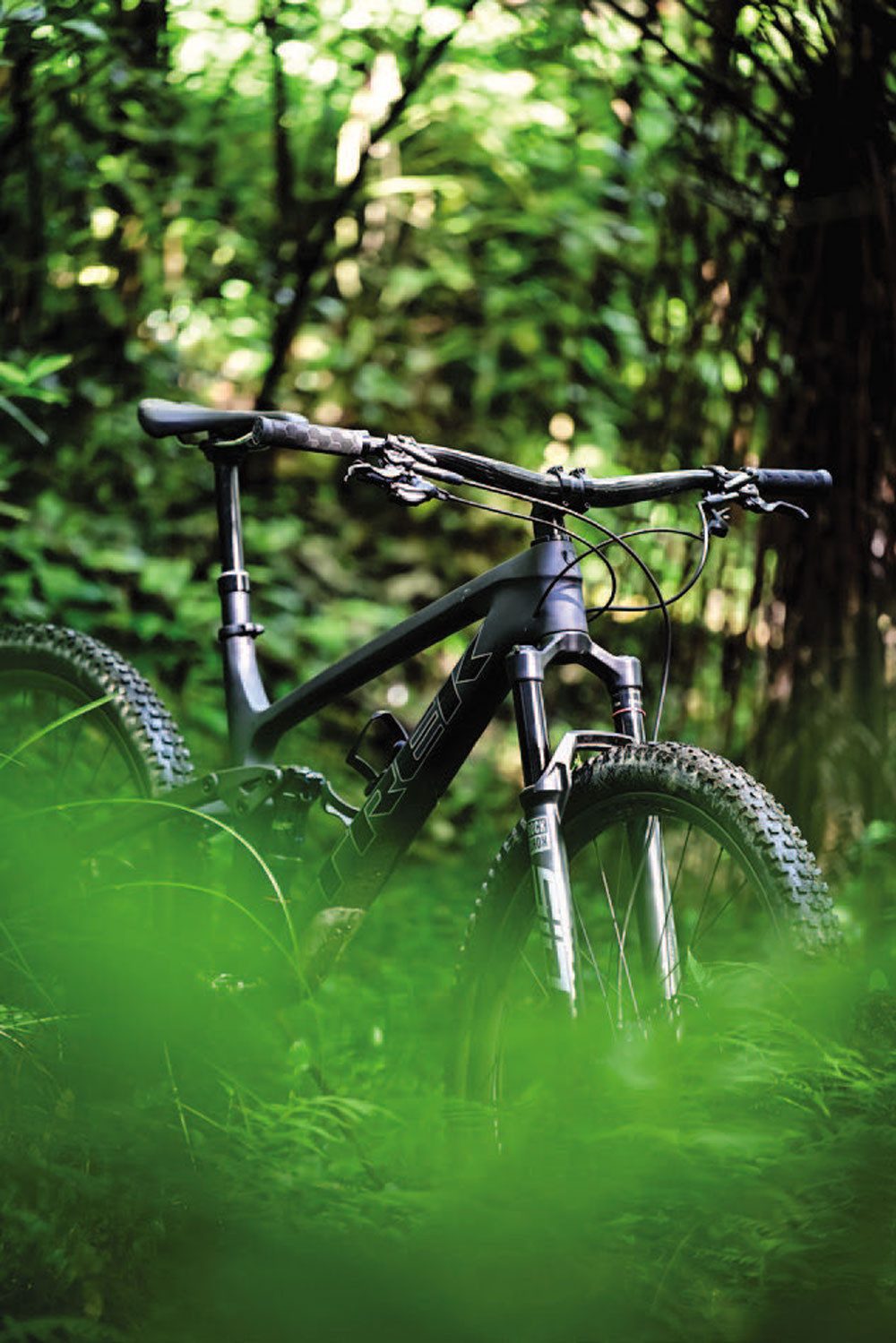
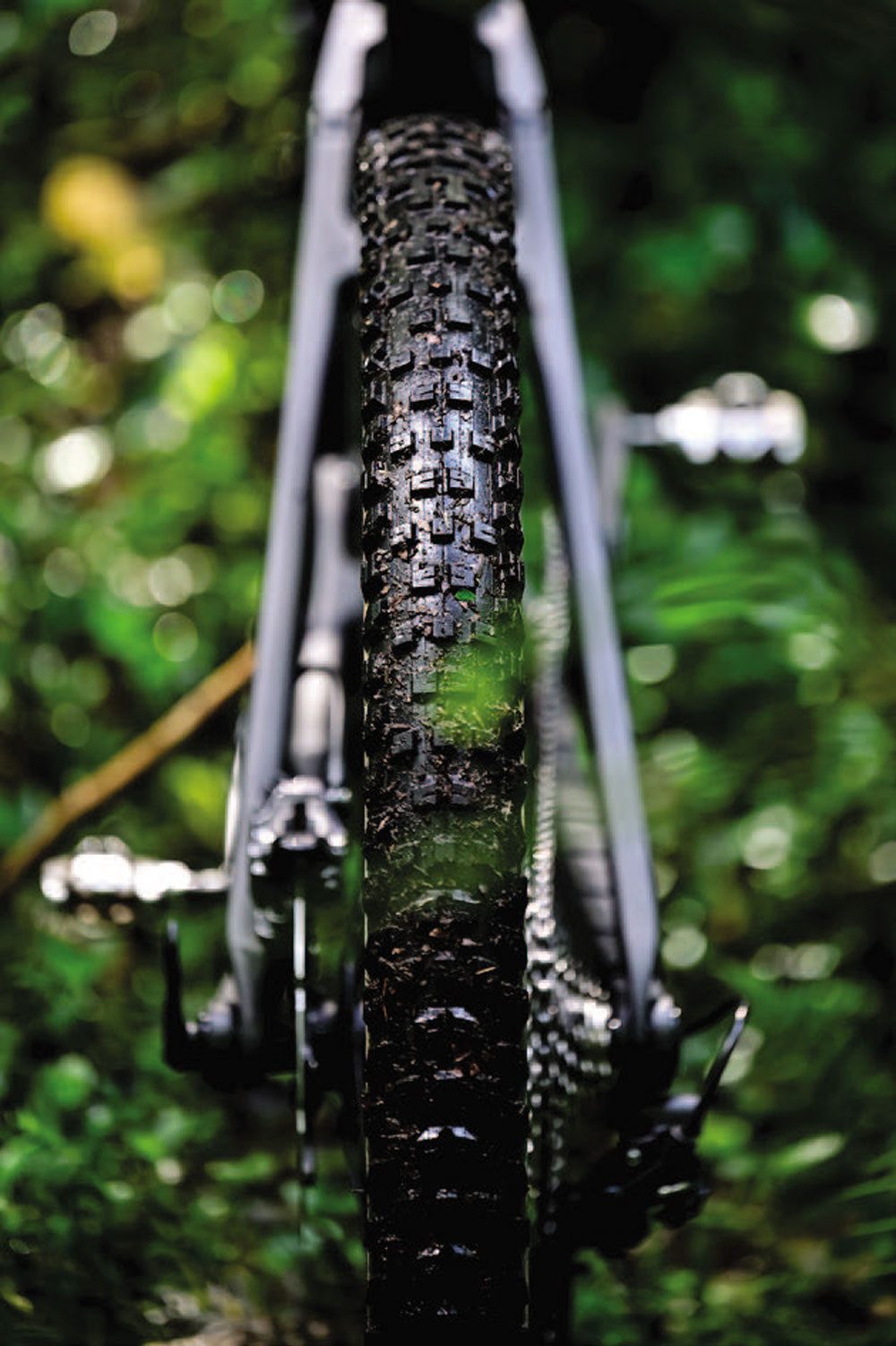
On the suspension front, the Deluxe Ultimate rear shock does a superb job at managing the rear travel through rowdy terrain, however, it does tend to show the limitations of the Select+ front fork. It’s not that the fork is bad – in fact, there is a lot to like – but it has an incredibly light breakaway (to minimise stiction, the SID Select+ is now using Maxima Plush damping fluid and SKF wiper seals) which means it does a superb job at absorbing small trail chatter. But, with only 120mm of travel to work with, mid-stroke damping is critical, and this is where the Select+ can’t keep up. A damper upgrade is around $300-$400, so not insignificant. It’s worth pointing out that upgrading to the SID Ultimate fork is also something you can specify in the Project One bike configurator. Interestingly, Trek say the frame is rated for a 130mm fork as well so, if this was our bike, we’d be seriously considering flicking the fork at the outset and putting that coin towards a Pike Ultimate, which would take the bike a further step away from the XC end of the spectrum. We think this better represents the kind of riding that buyers would be purchasing this for and would make better use of the bike’s capabilities as a whole.
The Bontrager carbon wheelset is worth mentioning. Rolling on the Line Elite rims, they are built from proven OCLV Elite Carbon for an optimized blend of weight, strength, and durability. They held up well during our test. The 108pt engagement freehub delivers rapid pickup at the pedals, but is definitely on the noisier end of the spectrum so you’ll either love it or hate it. There is something kind of obnoxiously satisfying about coasting up behind your riding partner while your freehub is screaming at them, just subtly letting them know that you’re coasting right now and could they please speed up?
The Top Fuel’s strength is that it just does so much of what a lot of us actually do – really well. For a lot of riders, the majority of actual hours spent riding isn’t on either an XC or Enduro race track; it’s probably spent heading out for just a few hours, with a mate or two, once or twice a week. It’s riding a bit of everything; the up and the down – and actually wanting to enjoy both.
It’s not launching five metre gap jumps, but it’s not riding around the one or two metre gap jump either.
It’s the every day, every trail fun that is in the Top Fuel’s sights. It’s responsive, gets up to speed quickly and responds really well to rider input, such as pumping through rollers and, as a result, is simply really fast. It’s fun and efficient at every task and we think it will be a really good fit for a lot of riders. •
REVIEW: LANCE PILBROW
DISTIRIBUTOR: TREKNZ
RRP: $ 8 ,849


